Before I tell you one of the best stories you will ever hear, I have a confession to make. It is a confession that does not paint me in the best light and I risk having you think less of me. I guess that is a part of confessing. I will just get to it and air this so that I can spend some more time explaining myself. So here it is: I trespassed and spent time on the property of today’s mystery story.
Now allow me to recount the back-story. When I was in my teens and twenties I was very curious. As you have certainly picked up by now, I have long been obsessed with architecture and large, gorgeous homes. Like many of my curious friends, I was prone to high adventure—honestly, more carefree kid than a building sleuthhound at that point. Sometime, in the late 80’s, or early 90’s, a friend of mine moved into an attic apartment on Cuming Street, near the Cuming Street Food Mart. It was named something else back then but still was a little hinky, even for those days. This attic apartment was in one of those old, titanic, Walnut Hill Neighborhood homes that had long ago been broken up into apartments. I remember there was a perilous set of stairs winding up the side of the home, which scaling with a group was an adventure in and of itself. As the night wore on, one friend in the group wanted to show the rest of us something he had found recently: a Castle. Stupendous, we thought. We all packed up and headed back down those treacherous stairs to find that night’s enterprise. After a very short walk and a cut through an alley, he did, indeed, show us a Castle. I was absolutely affected by its glory. A silence fell over the group. We all cleared the fence with ease and, in memory, walked the large property, being as quiet and respectful as could be, considering we were intruding. The small Castle looked to have been built of stone and it was in the back corner of a large property. I estimated it to have been built in the 1960’s for someone’s children. I have never forgotten that magical, late night encounter from 26 some odd years ago. I would continue to take newcomers by the Castle for the next few years—although always viewed through the alley, reverently from a car.

When I began to think about starting myomahaobsession, I knew that the Castle was a Forever Mystery in my mind, needing to be solved. The twists and turns in the research of this story alone have provided months of intrigue for me. I found the Castle, itself, to be just one part of the puzzle. It has truly taken on a life and I allowed it to. So let me begin to tell you one of the best little Omaha secrets you will ever hear and assure you that Joslyn Castle has nothing on this Walnut Hill Treasure.

Lay of the Land
4025 Izard Street is tucked away, geographically speaking. You might never have met its acquaintance unless traveling on foot. An east-west street, Izard was named in honor of Mark W. Izard, third territorial governor of Nebraska, by Governor Cuming. Conveniently, Cuming Street is a mere block south. Although Izard runs throughout Omaha, mind you, a few jogs here and there, this particular stretch of Izard Street, (4oth Street through 42nd Street) is bound on the east side by the Mercer Mansion. Further to the east, Mercer Boulevard and Mercer Park Road continue to add buffer with additional blockage contributed by curving Lincoln Boulevard. West of 42nd Street down to Saddle Creek-Radial Highway is largely defined by industrial buildings, although houses continue past 45th Street. Like most of the Walnut Hill Neighborhood, there are lots of kinks and quirks—making it all the more fascinating.
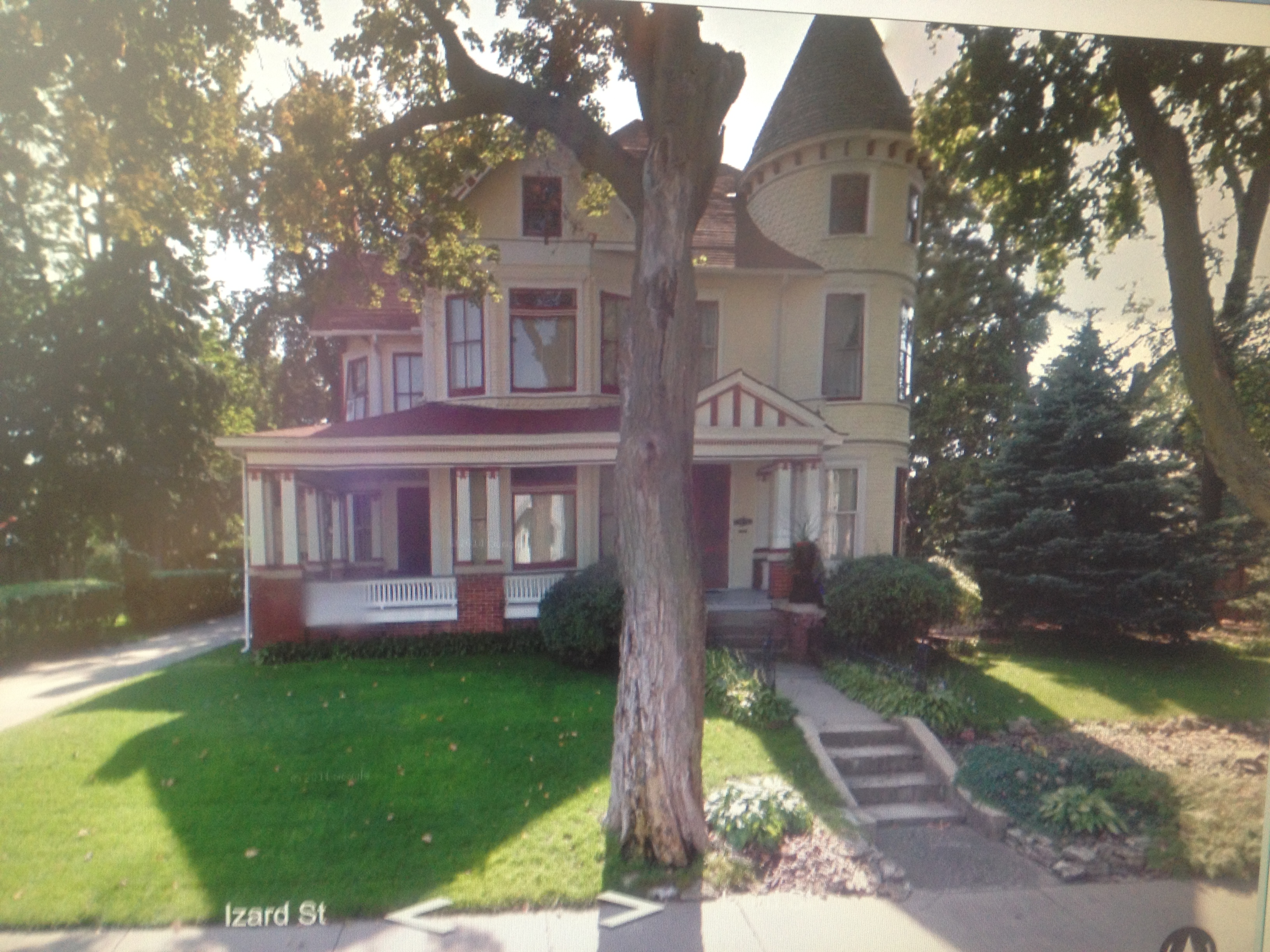
Just three doors down from the Mercer Mansion, 4025 Izard, is one of the remaining single-family dwellings from this majestic part of town. Its beauty is breathtaking, even to this day. 4025 has always held its head high due to a series of restoration minded, community focused owners. I was pleased to find that the Reconnaissance Survey of 2003 for the Omaha City Planning Department identified 4025 Izard Street for it architectural significance and recommended that it should be eligible for the National Register of Historic Places. The house was prominently featured in the report as a superb example of the popular Queen Anne style, displayed in its irregular form, decorative shingle work, porch, spindles, turrets, and tall chimney. I found a number of homes in the Walnut Hill Neighborhood were listed in this 2003 report. For more information on Walnut Hill, please check out Adam Fletcher Sasse’s blog http://northomaha.blogspot.com/2015/11/a-history-of-north-omahas-first.html.
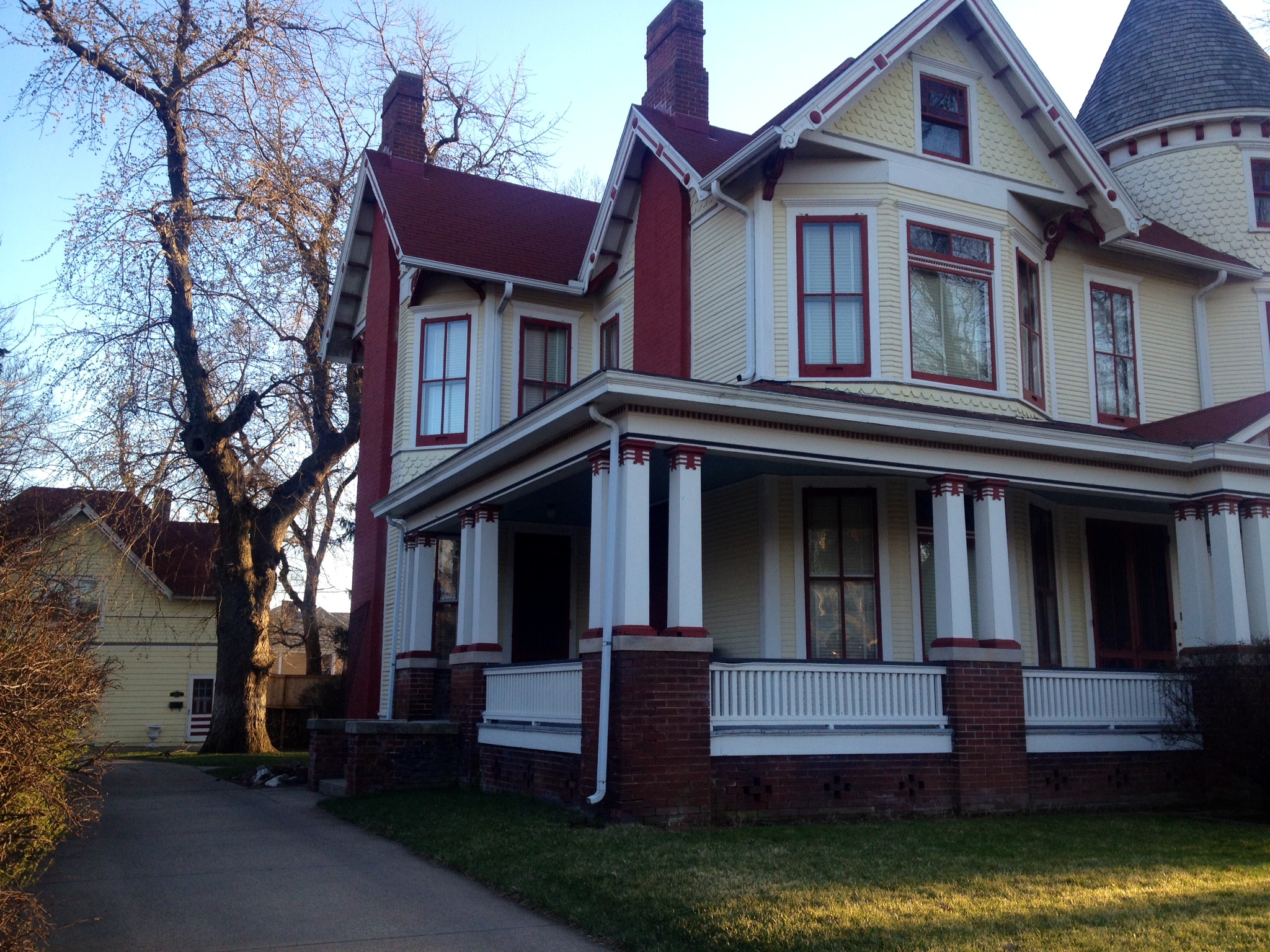
The Beginnings of 4025 Izard
Through my research I found that J.B. Mason built 4025 Izard, in 1890. J.B., also known as James Bayne Mason, was a local architect, perhaps, a less mentioned contemporary of John Kiewitt and F. A.Henninger. Mason was born in Scotland in 1846. He was originally an agricultural implement maker in Morrison, Illinois according to the 1880 federal census. By 1886 he had made his was to Omaha. The 1891 city directory found him living at 4025 Izard, occupation listed as “draughtsman” for the first time. An English word, draughtsman is a person who prepares technical drawings and plans under the direction of an architect or engineer. By 1896 he was listed as an “architect” in private practice. I discovered Mason’s office was at 309 South 17th Street. This address no longer exists but it looked to be just east of the Douglas County Courthouse. In the 1920’s, that same office would house the Omaha Stationary Company. He also had an office at the Paxton Building through the years.

Mason lived in this house of his design for a number of years with his wife, Maria and their three children Mable, Claude and Nancy. It is significant that he built 4025 Izard just five years after Dr. Samuel Mercer had built the infamous Mercer Mansion at 3902 Cuming Street. The rising Walnut Hill Neighborhood was one of the most prestigious areas in Omaha and Mason, no doubt, wanted to have his home situated in this up and coming part of town. The two must certainly have brushed shoulders at this time. Using over twenty types of wood and the finest materials available to an architect at that time, Mason’s home was as large and as it was beautiful. From different sources, I found some conflicting information. A number of sites reveal there are 6 bedrooms, 3.5 baths, for a total of 4,583 sq ft. and other sites, such as the Douglas County Assessor, reported the home as being built in 1900, having five bedrooms, 2.5 baths and 3,584 sq ft. This discrepancy may be due to the additional square footage of the carriage house which was added in 1910, now an apartment. I wondered if this incredible architect, credited with designing numerous buildings and private homes around Omaha had also created the Castle for his children. I couldn’t find anything about that in the records.

A New Owner
The clues then led me to J. A. Swanson, or Johnathan A. Swanson. Swanson bought the house, living there from 1907 through 1921. In those years Swanson was president of King-Swanson Company. An immigrant boy from Sweden, Swanson came to America by himself at age 15. He secured a job in Stanton, Iowa working at a general store and post office. He later moved to Omaha and worked at Hellman Clothing, and Hayden’s Clothing department, where he became a buyer and manager. He then established King-Swanson Company, a men’s clothing shop.
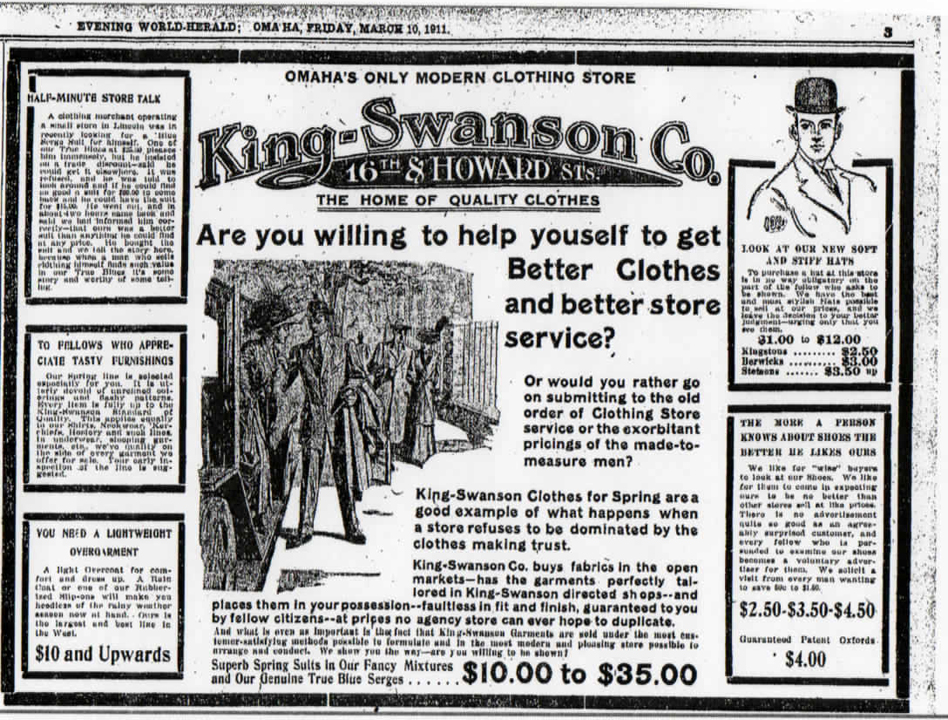
Fantastic looking ad from March 10, 1911. “To fellows who appreciate tasty furnishings.”
Oddly, in the years of 1916 and 1918, the name of W. O. Liljenstople was listed at 4025 Izard in addition to Swanson. I soon uncovered the Liljenstople was a prominent local banker and employed with the United States National Bank. I wondered if the large Izard Street home was being shared by two families at that time. After 1918 the home is singularly listed in Swanson’s name again.
After four years, Swanson sold his interest in the King-Swanson Company and, along with a partner, bought the renowned Omaha business, the Nebraska Clothing Company. By 1921, Swanson and his family had moved from 4025 and were splitting their time between a 160-acre farm near Florence, a lake cottage in Paynesville, Minnesota and The Incredible, To Die For House at 418 North 38th Street in Omaha. Obviously Swanson was a success. He died in 1929 at age 64. His son, Otto, would go on to run Nebraska Clothing Company and later form Inclusive Communities along with other prominent local business leaders.
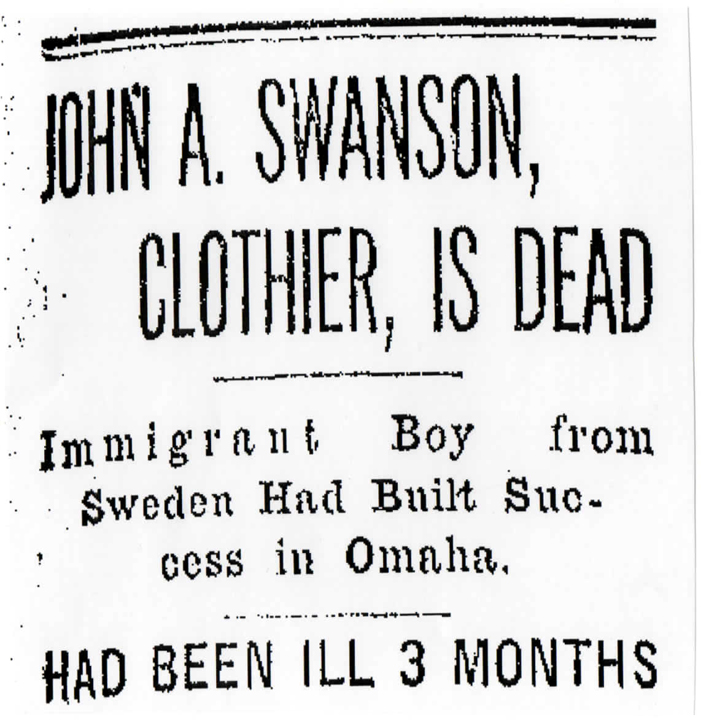
Swanson’s obituary article from January 31, 1929.
My favorites are the shockingly, direct headlines from this time period.
I could find no indicator that the Castle was built during Swanson’s ownership of the property. At this point in the mystery research, I figured that anyone of these wealthy owners could have hired someone to build their children a castle and it would never make the news.
Another Prominent Owner
Puzzling, the next few years were difficult for me to piece together due to the 1922 city directory being missing from the library. The 1923 city directory had 4025 listed as “vacant.” The 1924 city directory was also missing from the library. I found in the American Chemical Society newsletter of 1923, that a Mr. F.J. “Fred” Mleynek had been a newly elected council member of said Society between October 15 and November 15th of that year. His address was listed as “4025 Izard Street, Omaha, Neb.” Those breadcrumbs led me to the Chemical Bulletin Vol. 10, No. 11, which stated “F. J. Mleynek, Class of ’23, Chemical Engineer, is now located with the testing laboratory of the Union Pacific Railroad of Omaha.” So although I was not exactly sure what years Mr. Mleynek lived at 4025, there were pieces of evidence that he occupied it at some point during those three years and worked at the U.P.
An Obscured Ownership
In 1925 “A. E. Fletcher, physician” had bought the home at 4025 Izard Street.
By 1928 the Omaha city directory listed the property as “A. E. Fletcher phys @ Park Hospital.” I thought maybe they had listed this, referring to his place of business. In some years, the directories would list a homeowner’s profession—to include a business office address. (Honestly, there is a whole lot of variation from year to year in the city directories.) It wasn’t until I found the 1934 listing of 4025 Izard under “Park Hospital” with no owner’s name, that I became completely confused. This is where the story began to take flight for me. I thought there must have been some kind of mistake. I needed to know more.
Even more confounding still was the 1939 listing for 4025:
Asa Fletcher
Park Hosp
D-Flo Chemical Co
Urego Chemical Co.
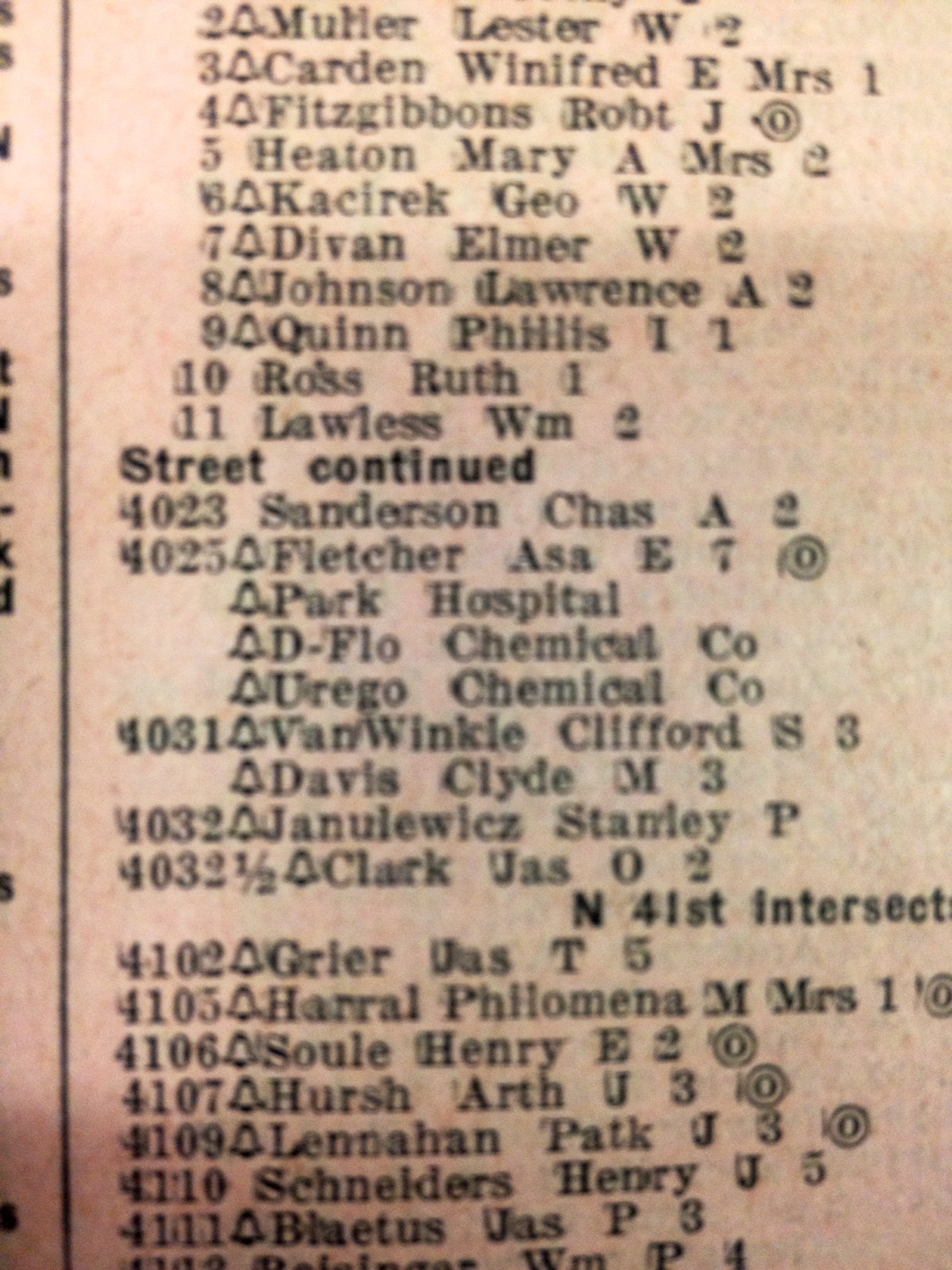
I was intrigued. I asked the librarian if she had ever seen that many company names listed after a home address. She had not. I guessed that maybe Dr. Fletcher had sat on the board of all of those companies. The librarian thought that might be the case. It was so odd that there were different phone numbers listed for each business but under the same address.
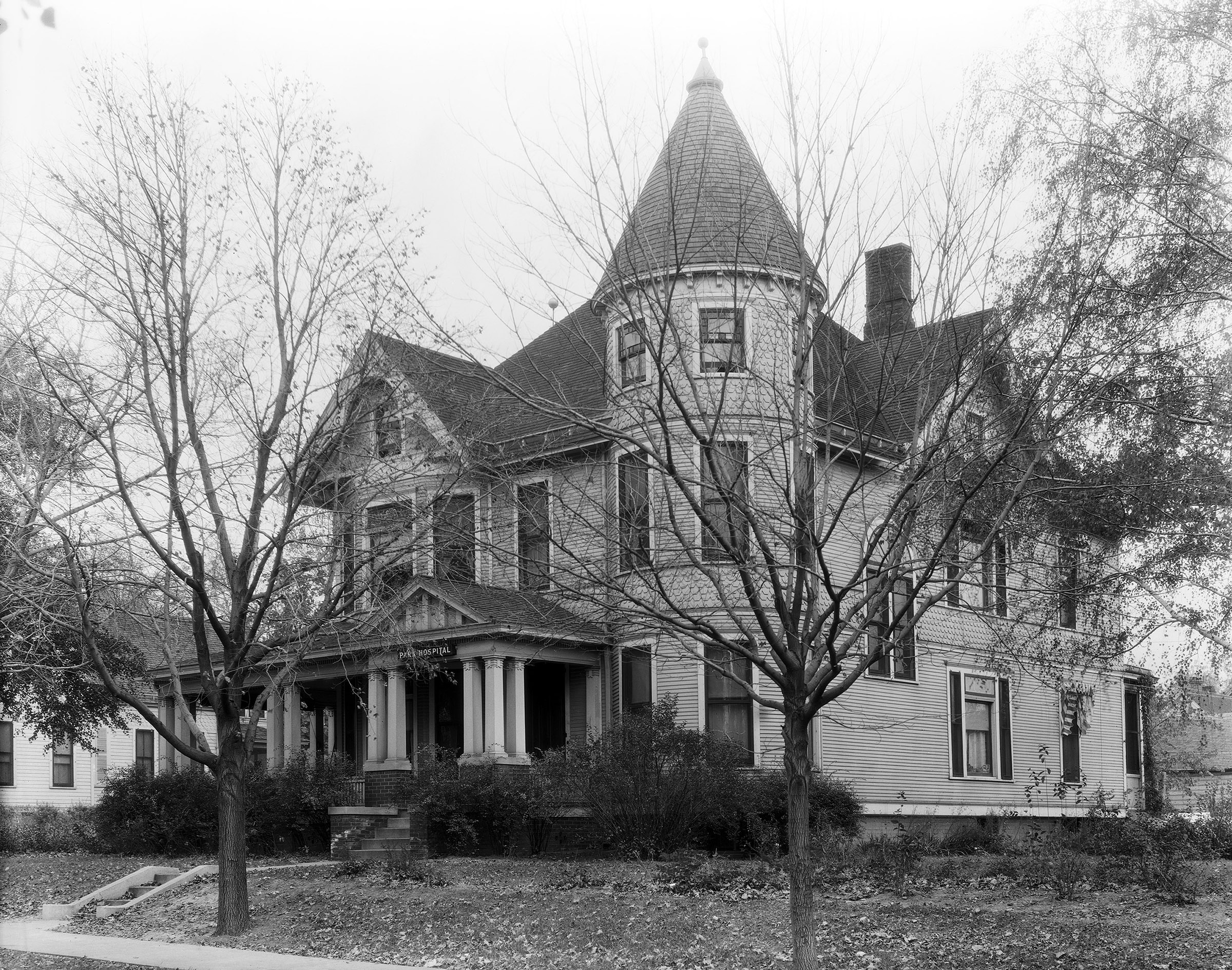
Photo courtesy of the Nathaniel Dewell collection at the Nebraska State Historical Society archive. October 30, 1928. The sign above the door reads Park Hospital.
Around this time I found these stark photos of 4025, labeled “Park Hospital.” It was a pleasure to work with Marty Miller at the Nebraska State Historical Society in order to gain permission to use these photos. Nathaniel Dewell captured them on October 30, 1928.
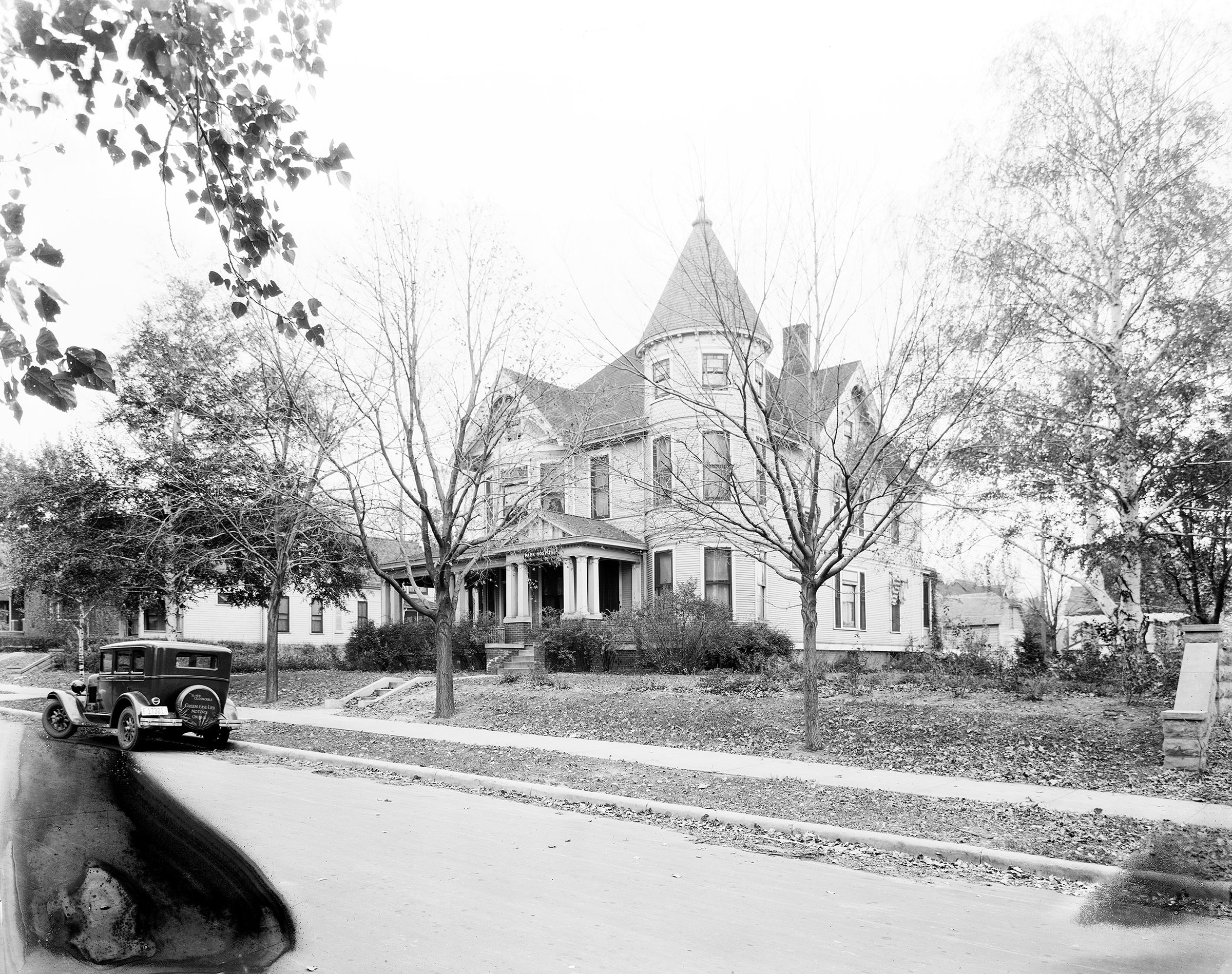
Photo courtesy of the Nathaniel Dewell collection at the Nebraska State Historical Society archive. October 30, 1928. Northwest angle on Izard Street.
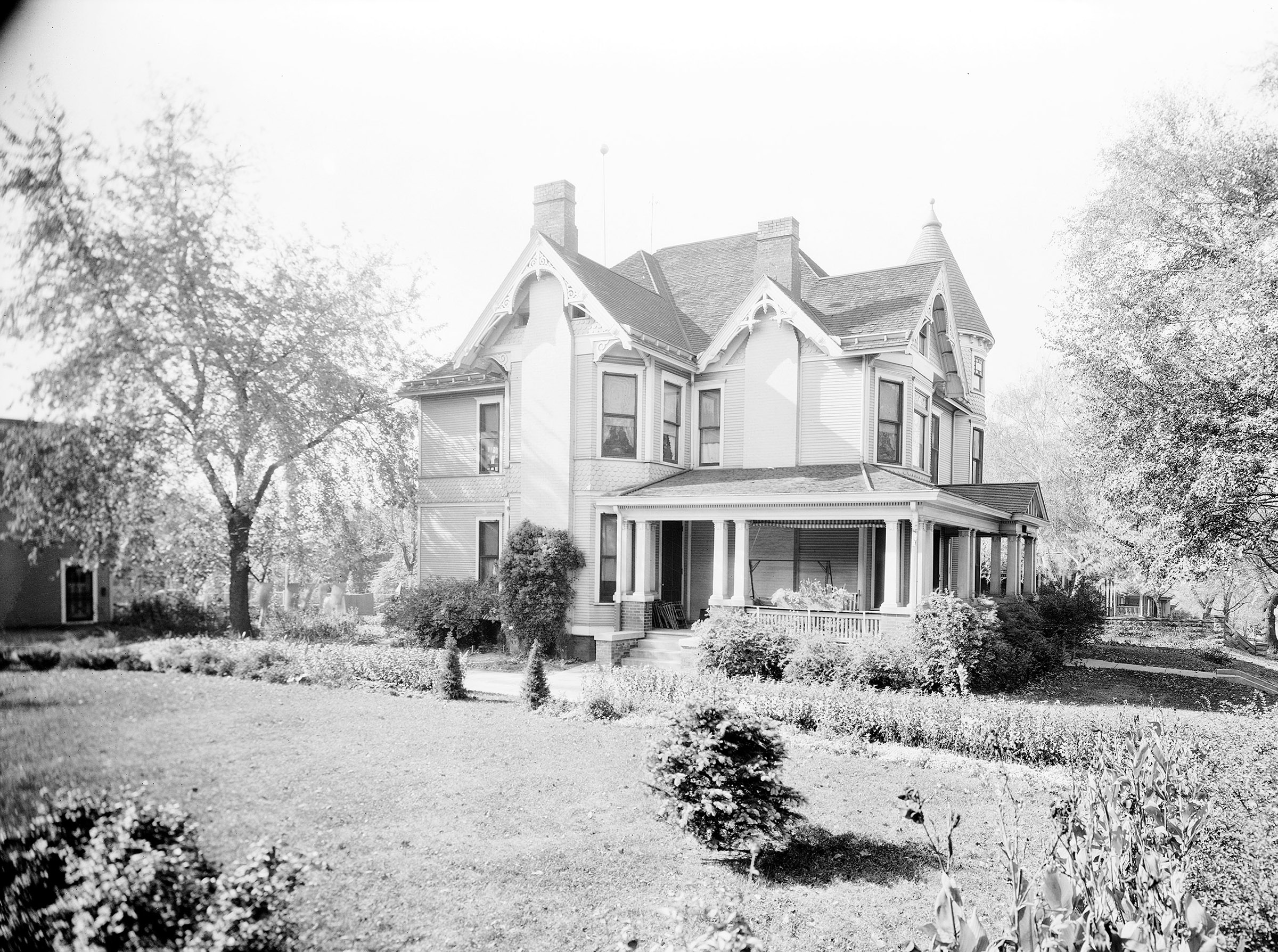
Photo courtesy of the Nathaniel Dewell collection at the Nebraska State Historical Society archive. October 30, 1928.
East view of the house and grounds.
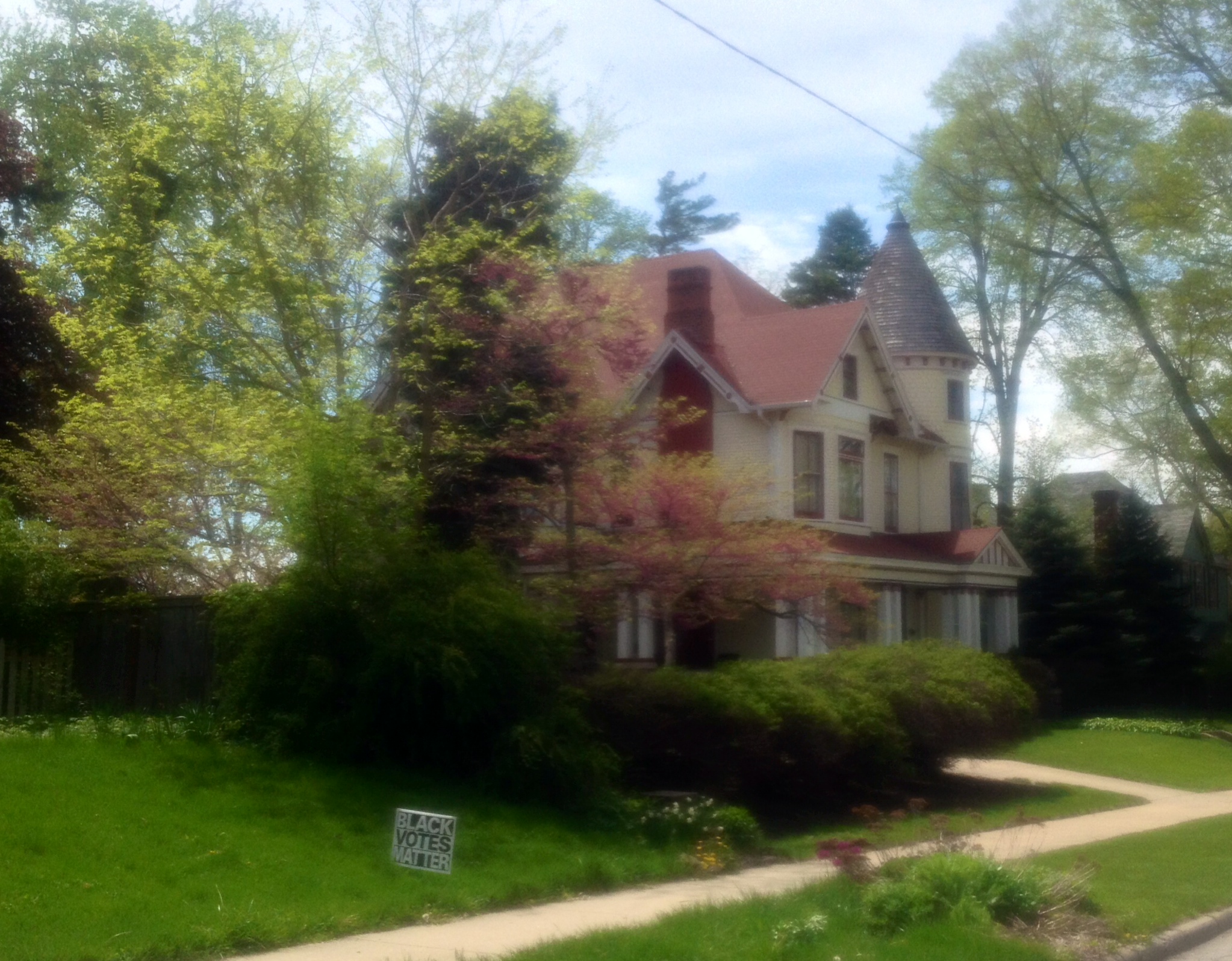
The east view from 2016.
I began to cross reference in the city directories, in an attempt to find Park Hospital, D-Flo Chemical Co or Urego Chemical Co. There were no listings or acknowledgments of these companies in the Omaha business pages, which I thought was mighty strange. I knew then that I would have to dig a little deeper into this Dr. Asa Fletcher character.
What I found was the best waiting-to-be novel ever. Asa Fletcher was born in 1884 in Ohio. Through the National Eclectic Medical Association Quarterly Vol. 11 of 1920 (years before Fletcher would move into 4025), I learned “Dr. Asa Fletcher has changed his address from 1041 North 33rd Street to 3328 North 27th Street, Omaha.” The quarterly also featured medical treatments such as Plant Protein Therapy and Metaphysic Passionmania. Page after page displayed photos of plants as medicine. I was fascinated and immediately knew I would need to report these findings to Mr. Cassette, whose own obsession is plants.
Under his “new” address (thanks to the Eclectic Medical Association) from this time, I traced him to the 1920 US Census: 3328 North 27th Street: Asa Fletcher, 38, Flossie Fletcher, 27 Wallace Krieg, 25, Ethel Hardin 25, Katherin Krieg 15, Donna B. Fletcher, 2. Who in the heck were all of these people? I wondered if the Fletcher’s had a large servant staff. (I later learned that Flossie, wife of Asa’s, maiden name was Krieg. These must have been her siblings.)
I began to look into Eclectic Medical practices, wondering if it was like homeopathy or the alternative medicine of today. Apparently much like today, the practice used a varied prescription of natural cures alongside different substances and exercise-based recuperation. It was popular in the last part of the 19th and first half of the 20th centuries. An eclectic doctor would utilize botanical remedies, Native American use of therapeutic plants, organic science, natural medication, counsel patients and offer cures via mail. The word eclectic alluded to those doctors who utilized “whatever was found to be gainful to their patients.” “Standard medical practices at the time made extensive use of purges with calomel and other mercury-based remedies, as well as extensive bloodletting. Eclectic medicine was a direct reaction to those barbaric practices as well as a desire to restrict Thomsonian medicine innovations to medical professionals.”
I learned the last eclectic medical school closed in Cincinnati in 1939. Fletcher was from Ohio. It was all clicking. I was fascinated to imagine that Fletcher was an eclectic doctor and was running an alternative, private hospital out of his home. That all made me think he might just be the kind of daring fellow to build a castle in his backyard.
Later I found in the Alphabetical List of Registrants of Trade-Marks from the Official Gazette of the United States Patent Office that Dr. Fletcher had applied for a number of patents through the years. In 1920, under the name “Urego Chemicals Laboratories,” Fletcher had filed a patent for “Skin Preparations for Certain Purposes, No. 131.653.” There were numerous “Skin Preparation” patents over time. I was beginning to understand that Urego Chemicals Co. (from the city directory) was one of Fletcher’s companies offering naturalistic cures through the mail. I was so thrilled to find that he was an inventor. There were additional patents under the D-Flo Chemicals Company name as well.
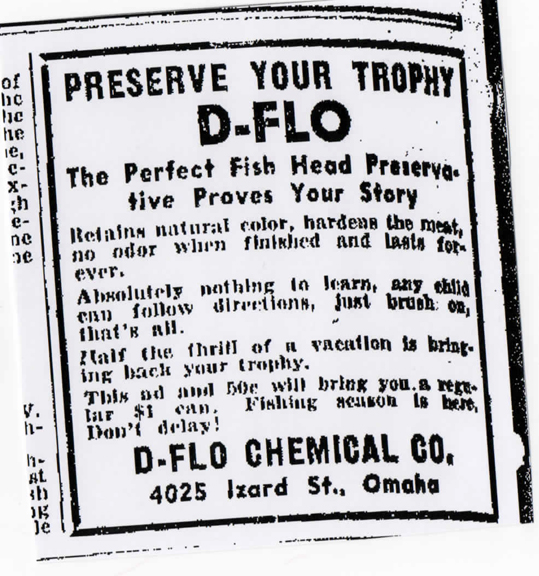
An ad from June 2, 1935 for D-Flo. It last Forever!
He Has a Castle in His Back Yard
Soon after, I found what I had been craving—an article from the Omaha World Herald from 1928, named, “He Has a Castle in His Back Yard,” complete with photos and illustrations. I about died. I exclaimed much too loudly for the library, “He built the castle!!!” I went up the to the research desk and excitedly told the young librarian what I had unearthed. Of course he didn’t know what I was squealing about.

Great article from OWH, November 11, 1928.
This article was a true delight to read–whimsical and well written, however too long to scan in a viewable size for this blog. I will include just a few details of it. Dr. Fletcher’s castle was built of many different stones that he collected from everywhere. He modeled it after a Normandy castle. He also built a pergola. There was a Venetian pool filled with lily pads, blooming flowers and gold fish. There was a rock border outlining the pool and stepping stones of all colors. He built the castle “because he saw the chance of creating something beautiful and artistic to grace his grounds; second, for a retreat from duties close at hand; and third, to typify in stone and mortar things that in life, have impressed him.” It is 22 feet high, 16 feet in diameter. The actual family home-hospital contained “20 or more rooms”, with 21 different kinds of wood, and “many fireplaces faced with pottery from Holland.” Donnabelle, his daughter, then 11, along with her two parents would often “gather in the castle in the cold weather for an evening of story telling, wienie and marshmallow roast.” Now this was very good stuff. I was beside myself…. and I had been wrong. He didn’t build the castle for children. He built it for himself. The article contradicted what I had previously read about Fletcher being born in Ohio and also my assumption that his medical degree was from a Cincinnati Eclectic medical school was incorrect.
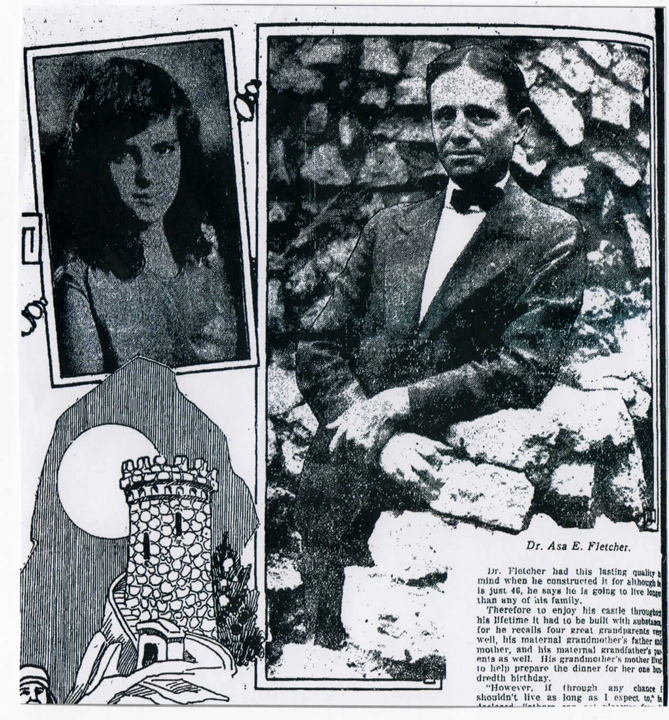
Superb detail of Donnabelle, age 11 and Dr. Asa Fletcher from November 11, 1928 article. Is anyone else excited that her name was Donnabelle? Just perfect.
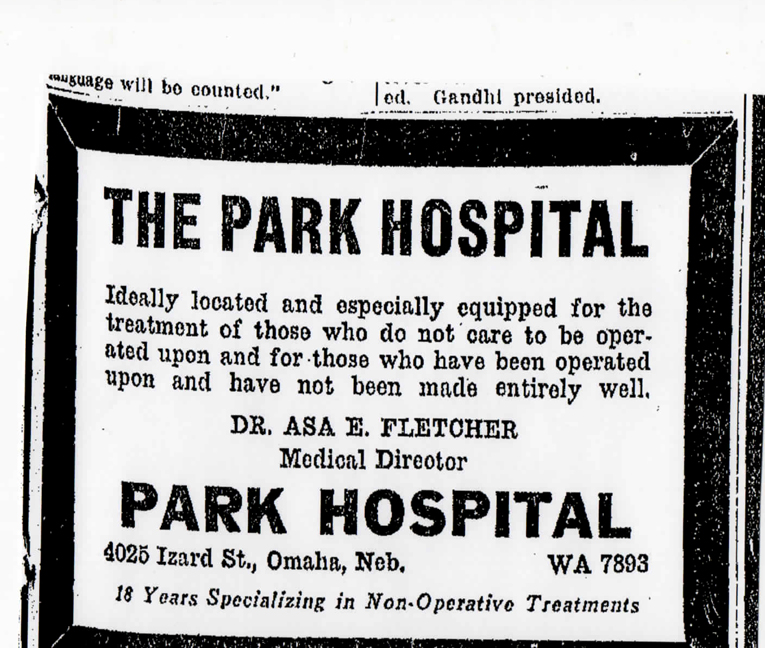
Probably my second favorite printed clue in all of this treasure trove of material was this ad from March 9, 1930. This simple ad in the World Herald gave me an idea of what Dr. Fletcher was trying to accomplish at Park Hospital. “Those who do not care to be operated upon…” Miss Cassette endorses this statement.
In March 12 of 1932, I came across the Omaha World Herald article, under the heading of New Incorporations, “Urego Chemical Company; capital, 25 thousand dollars; A.E. and Flossie K. Fletcher and R. Rhoades, incorporators.” That was quite the chunk of change for 1932.

August of 1933 brought two different World Herald articles about a grand party that was to be held at 4025 Izard. A “Castle Carnival” themed party described Donnabelle and friends hosting as part of the Job’s Daughters group. Over the years there would be mentions of Donnabelle’s involvement with Bethel 13, Order of Job’s Daughters.
More Answers and Even More Questions
By 1938, Dr. Fletcher was running ads in the newspaper that described Park Hospital as an “invalid and convalescent hospital.” The ad further describes, “Quiet, Restful, Homelike. Specially trained nurses and physicians. Very low rates, especially for those wishing to make this their home. Park Hospital. 4025 Izard. Omaha.” I was beginning to wonder who, exactly, worked at Park Hospital. All of the want ads that I saw throughout the years were worded similar to this, “Young Lady to learn to be nurse aid. No tuition to pay. We furnish board, room, laundry, books and laboratory equipment. Nor breakage fee to pay. Liberal salary while learning. Apply in person. Park Hospital.” Now that, sounded like a good deal. Who knows how many young gals worked there over the years? It would appear from the various ads that the staff was made up of women, young women, who were trained in the various eclectic medical modalities.
According to the 1940 US Census: Donnabelle Fletcher was now 22 years old and still living at home. Asa was 58, Flossie was 47 and Della (one of their mothers?) was 77 years old. Servants or hospital staff at the time was Lucille Store, 23, Doris Vetter, 21 and Margaret McPhodden, 19 years.
I discovered Donnabelle Fletcher’s wedding announcement in September of 1940 World Herald. She married Jack Witte Croft and the wedding was held at the Fletcher home…of course. I can just see that glorious event and the back yard, all decorated. I wondered if the patients and staff were involved in family functions?
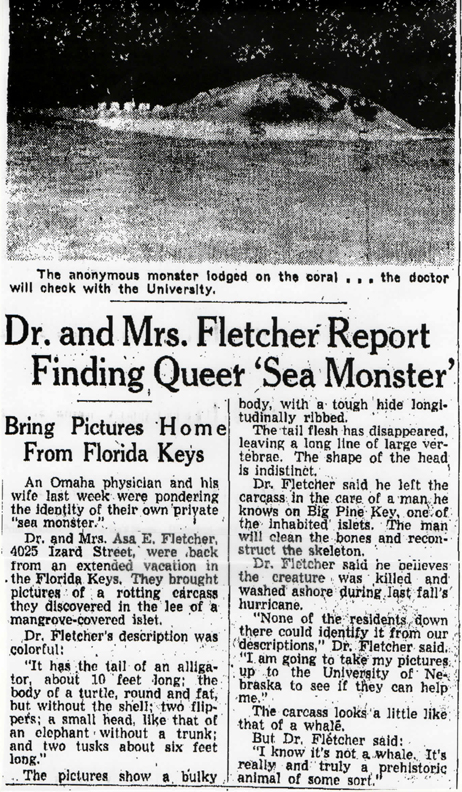
The World Herald ran a curious, little story from April 10, 1949 about a vacation Asa and Flossie Fletcher took to the Florida Keys. From the writing and photo captions I began to deduce that (possibly) people thought the Fletcher’s to be odd. I could be wrong about that. There was a mocking tone to the report and truth be told, a sea monster sighting, a hospital in their home, a castle, an inventor and an eclectic medical practice might have been too much for conservative Omaha society to handle. I wish I could know what the university told Fletcher when he brought in those animal carcass photos.
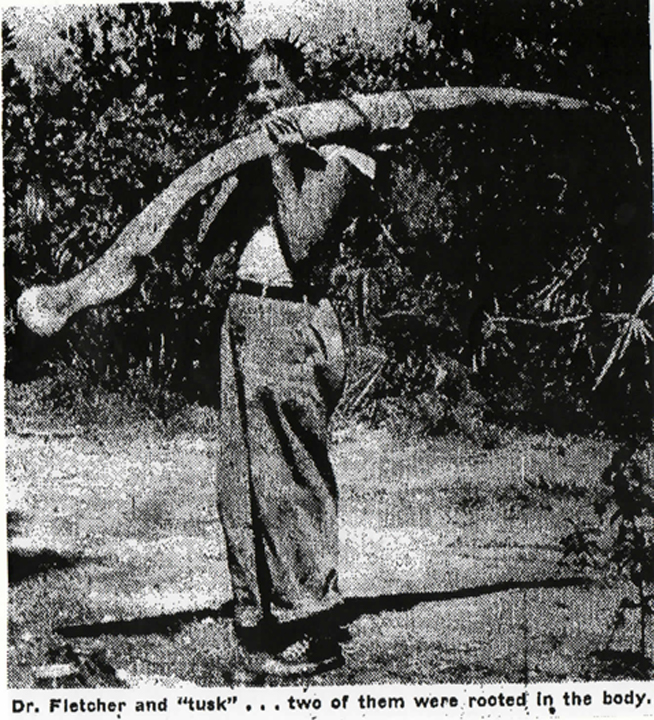
Another photo from the article of April 10, 1949 article showed the couple with their basket of sponges from their vacation. The caption reads, “Dr. and Mrs. Asa Fletcher…collect sponges, too.” I could be wrong but the implication, to me, was “We are very weird.”
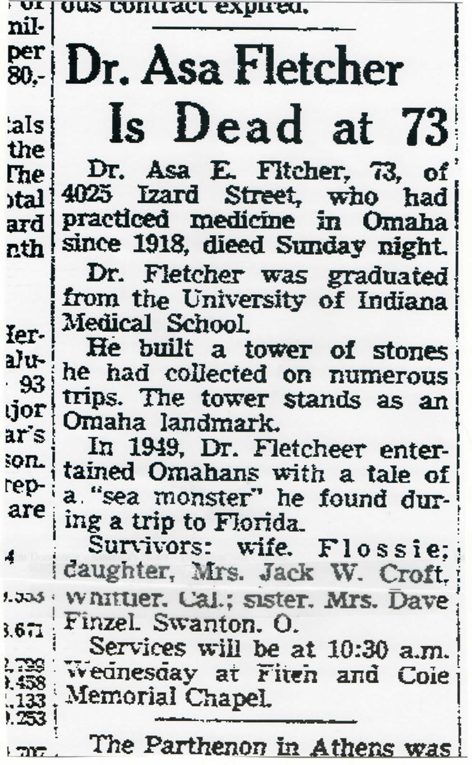
I was sad to find that in July of 1955, Dr. Asa Fletcher had died.
In the castle article he had stated that he would outlive his whole family, which did not come to pass. There are indicators that Fletcher might be buried at Westlawn or Hillcrest Cemeteries and I do plan to investigate this further. This obit mentions his castle and the sea monster—which I love.
Transition Period
4025 Izard then went vacant. I can’t help but wonder how the shutting down of Park Hospital went. Apparently Flossie Fletcher moved to Palm Springs, California at some point. She died there in 1986. Mr. Owen Moore bought the property next. I found his name listed in a 1957 directory. From 1961-1972 Bryan Wilson owned the house.
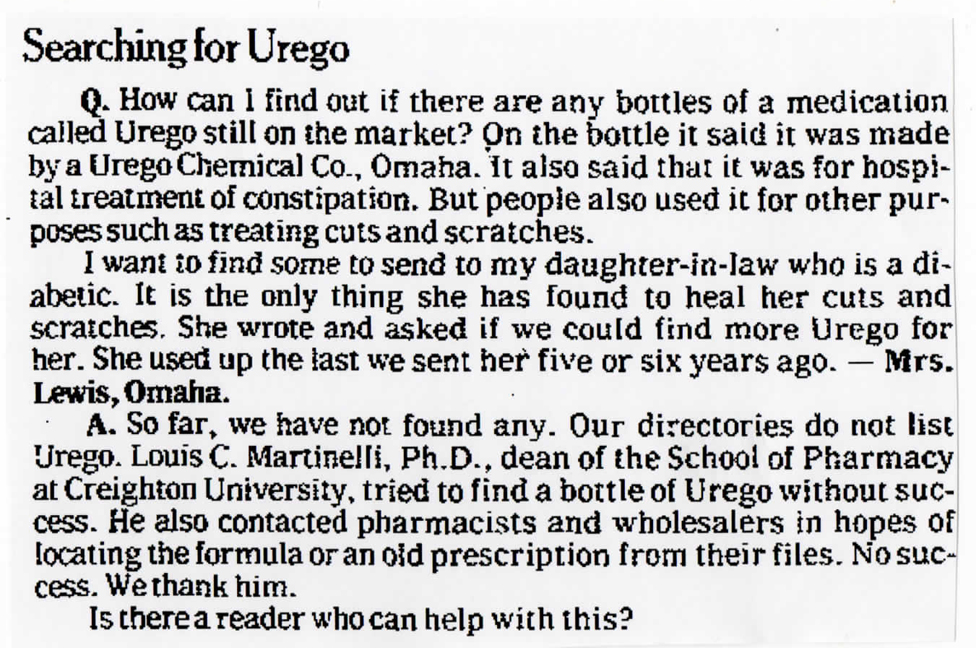
I had to laugh when I came across this. By April 5, 1979 a reader of the Omaha World Herald penned a letter asking if anyone knew where she could get a bottle of Urego. I like to think that by the late 1970’s some older woman still had her jar or bottle of 1940’s Urego Cream. I know this to be a distinct possible from looking in my grandmother’s medicine cabinet as a child–ancient blue and brown bottles with hand typed prescriptions taped on. Even the World Herald couldn’t solve this poor woman’s query….but now we know the answer and from where that great, natural medicine came.
New Era and Some Questions Answered
Not too long ago Mr. Cassette and I were walking along Izard Street to get some photos of the outside of 4025. I was pleased to see how well maintained the property was. I had done quite a bit of research about the current owners and knew they are very active in the Walnut Hill Neighborhood Association. In 2011 they were involved in gathering community support to educate and advocate for changes at the Cuming Street gas station due to problematic drinking, drugs and troubled youths. True stewards of 4025 Izard and fierce supporters of Walnut Hill, this couple has worked very hard to create community. I didn’t want to impose myself but when one of the owners approached us out front on that day, I was so pleased. I found them to be lovely and gracious but appropriately cautious. I explained myself and that I was writing a story about 4025. The owners have a good understanding that people are drawn to the castle and their gorgeous property. They only request that people ask permission before taking photos and entering their gardens. During this discussion I confessed to them that I had broken their rule as a kid. It felt good to come clean. Mr. Cassette and I were allowed to walk the property with them and take photos. What follows are the photos taken on that lucky encounter.
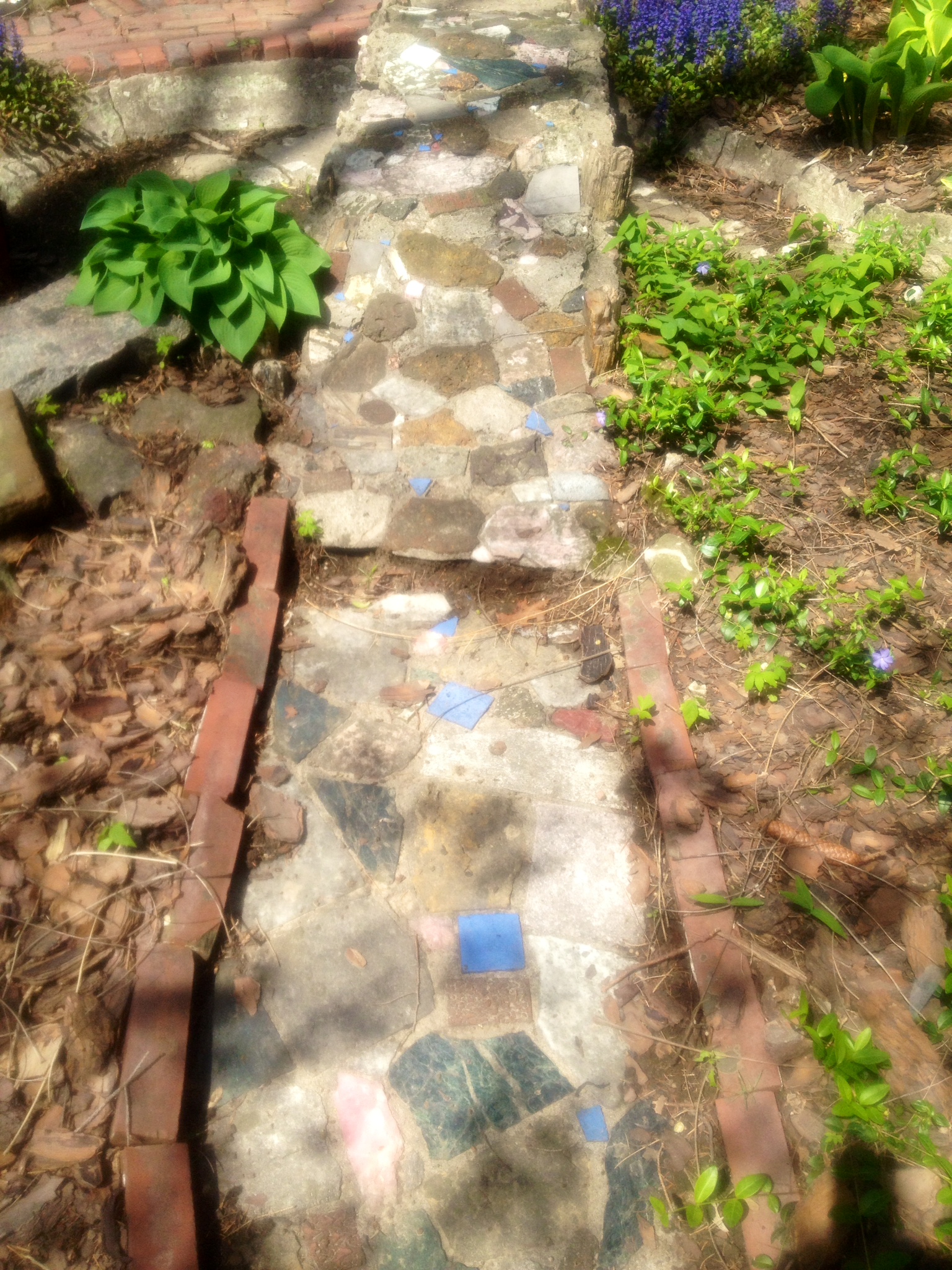
The colorful stone path that Dr. Fletcher created. To the sides would have been the original stream.

Very happy moss growing on Fletcher’s collected stones.
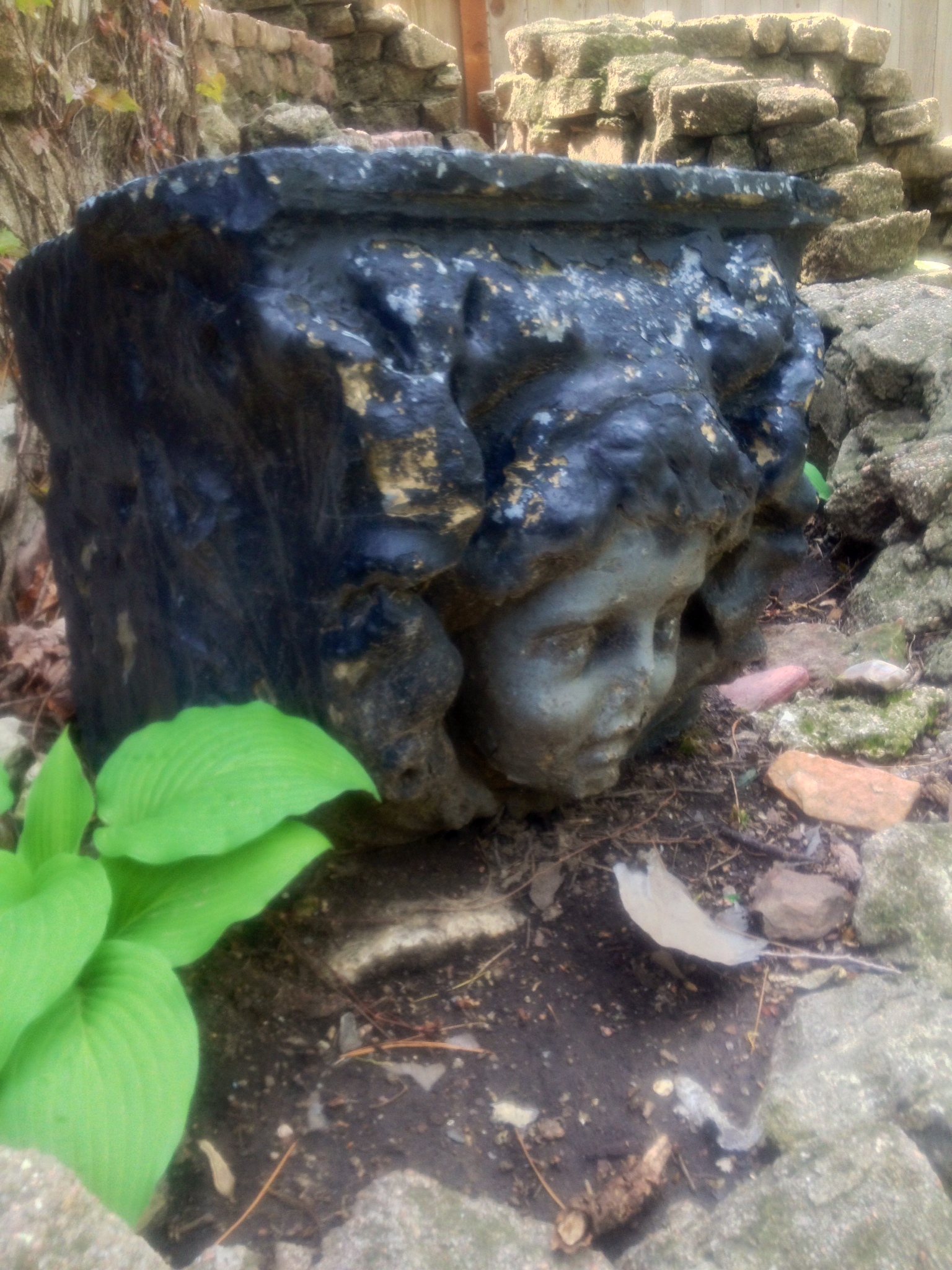
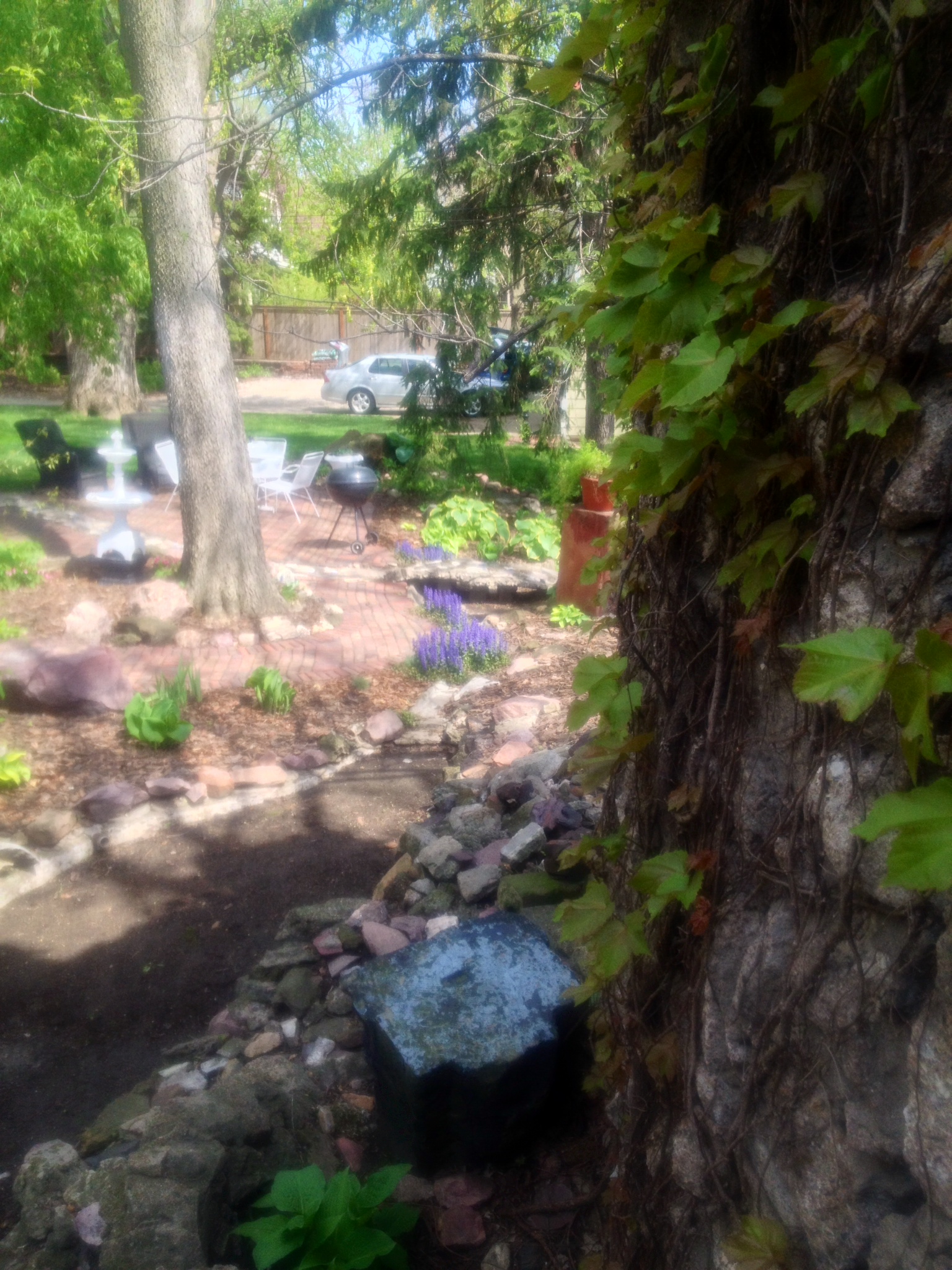
View from the winding stairs of the castle.
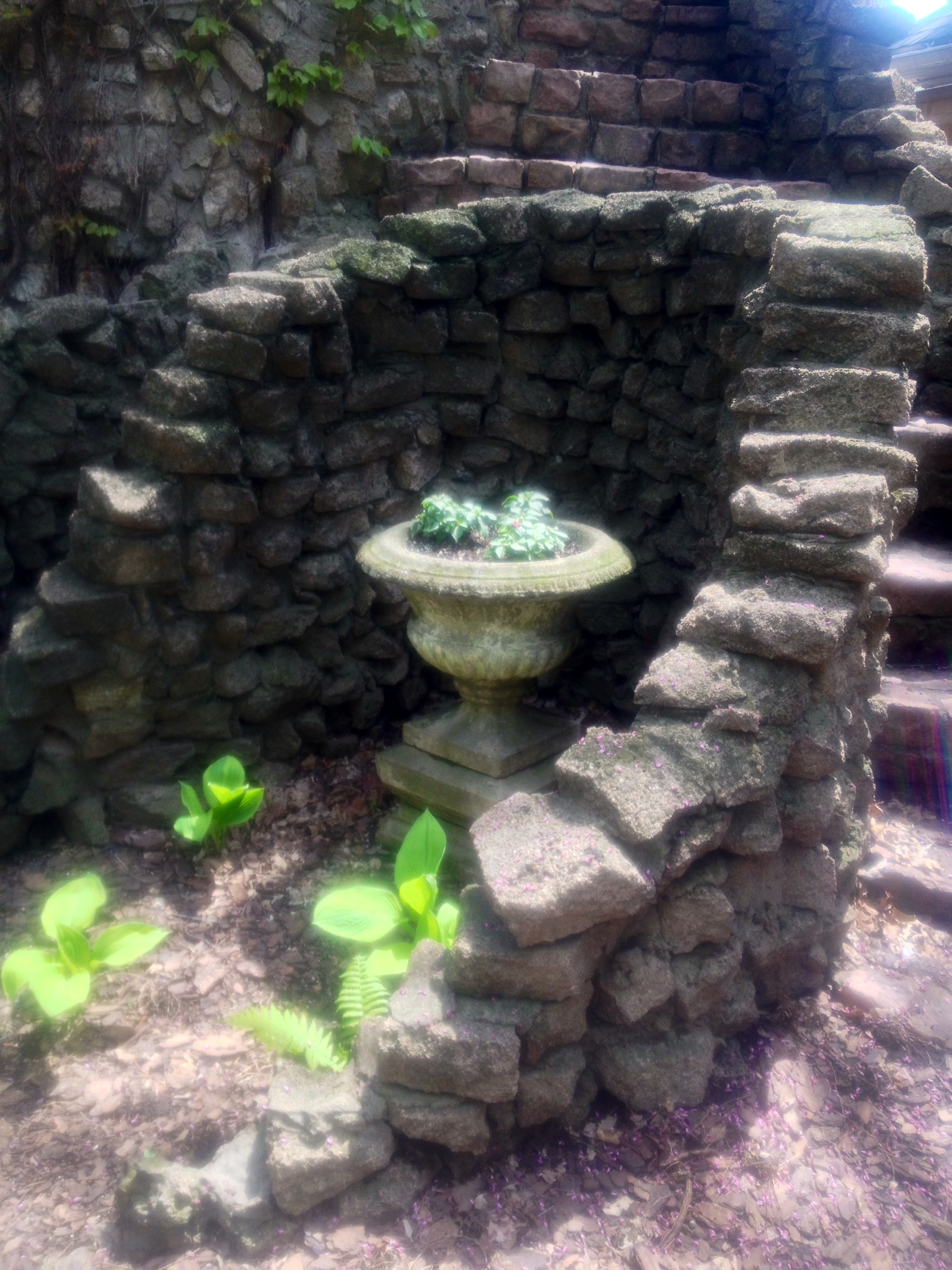
Dream like.
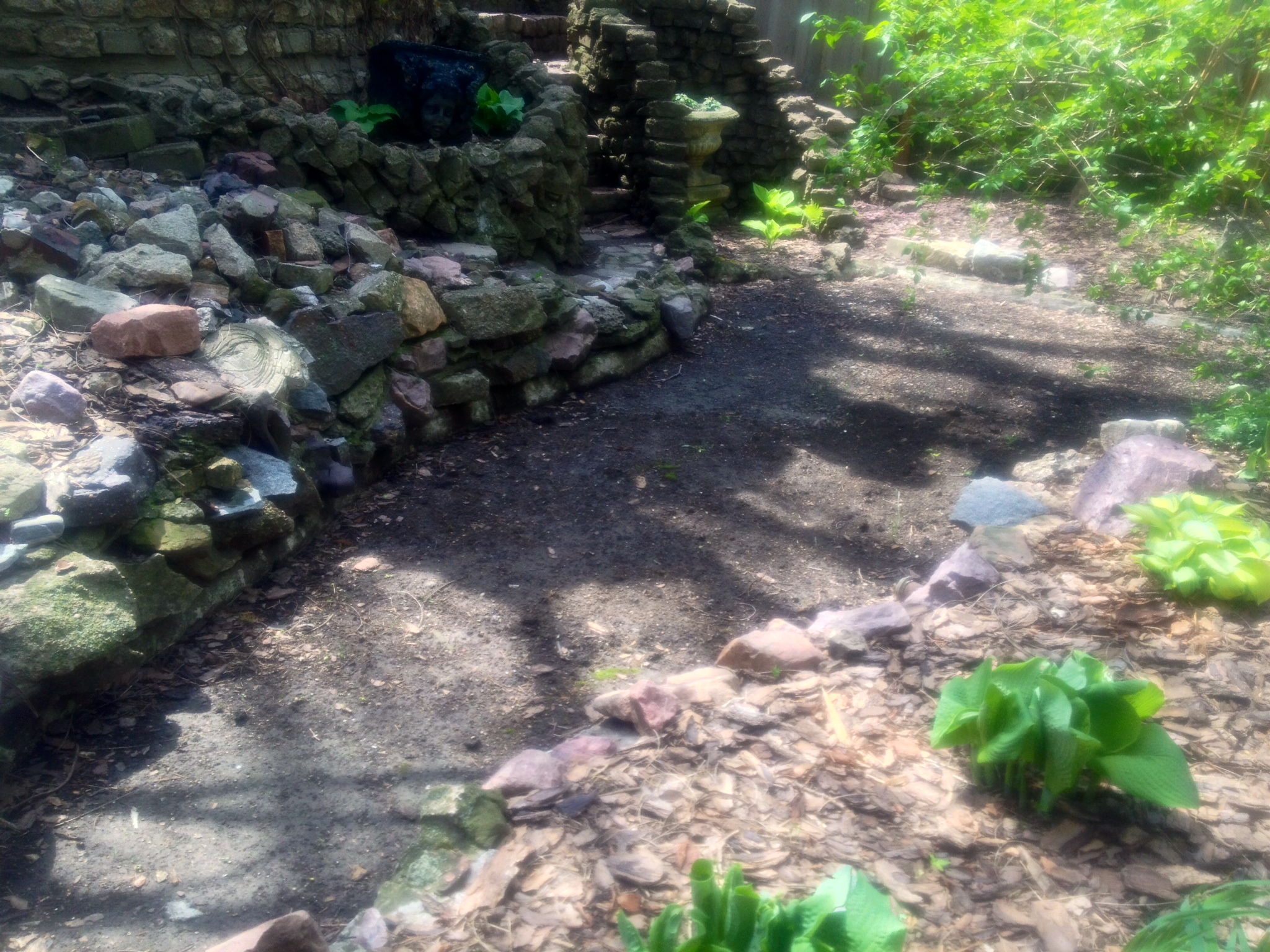
Where the pond had been, as previously described, filled with lily pads and gold fish.
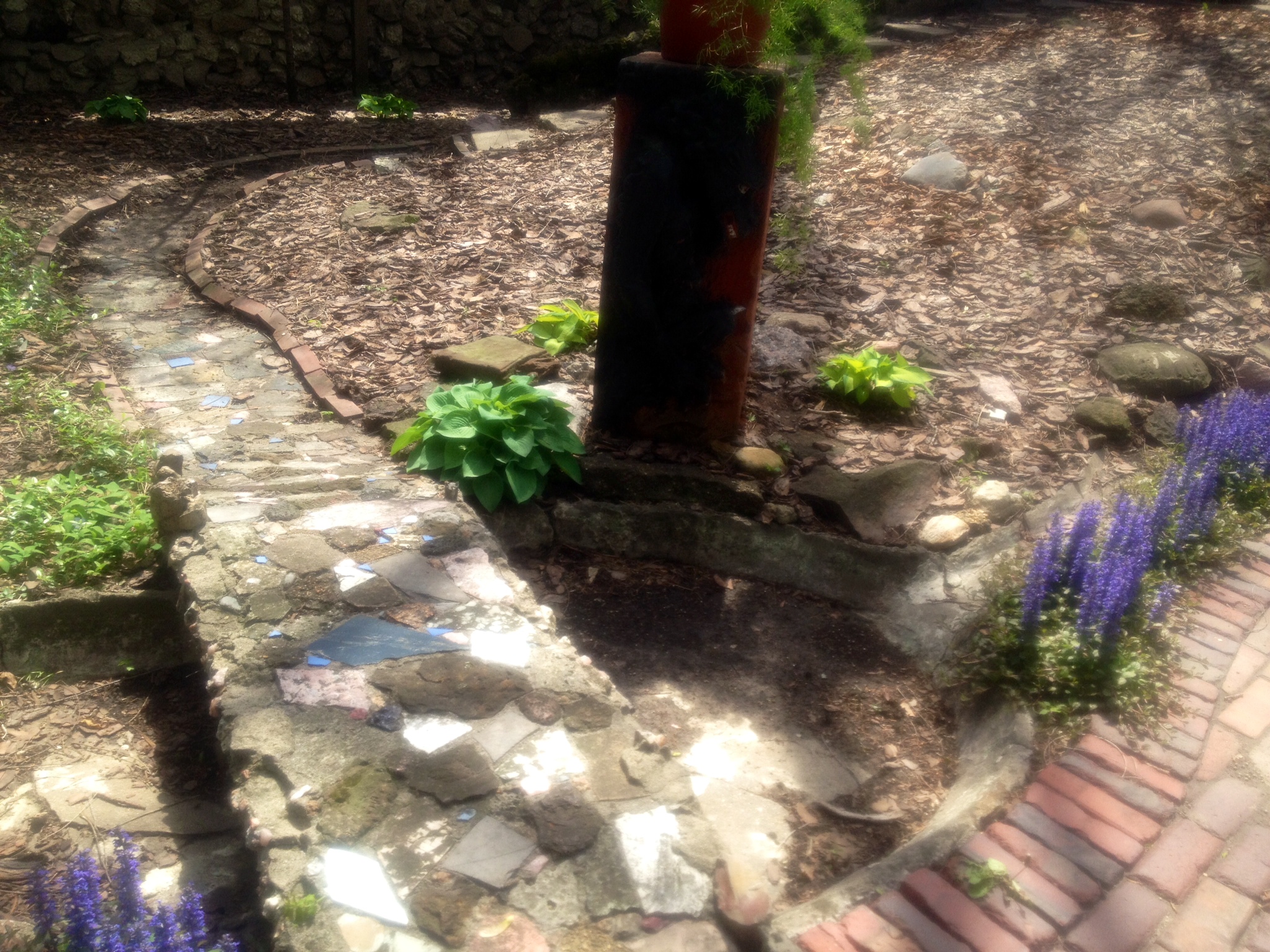
Stone path bridge going over the once full stream.
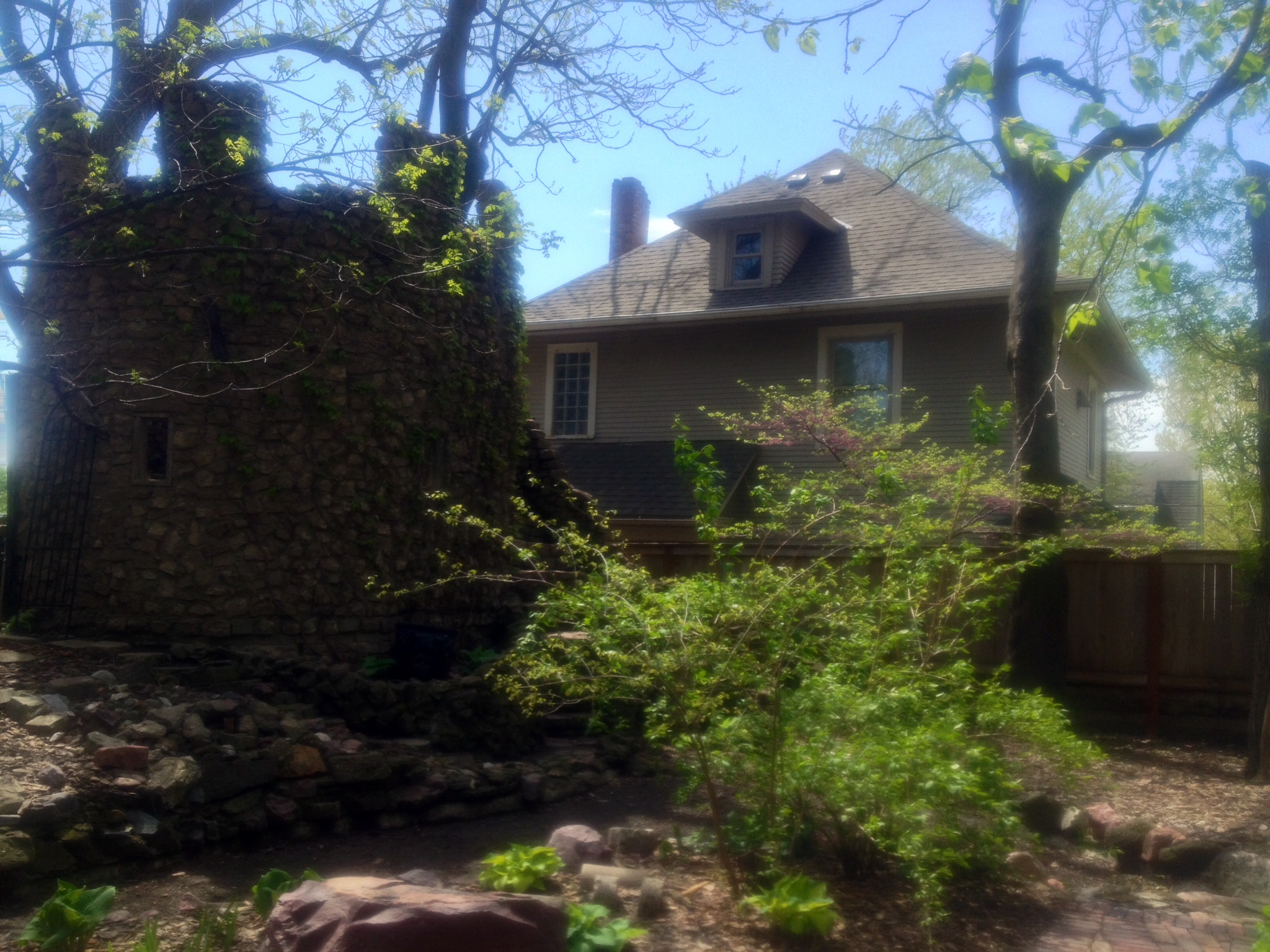
The castle with neighbor’s home in the distance. 2016
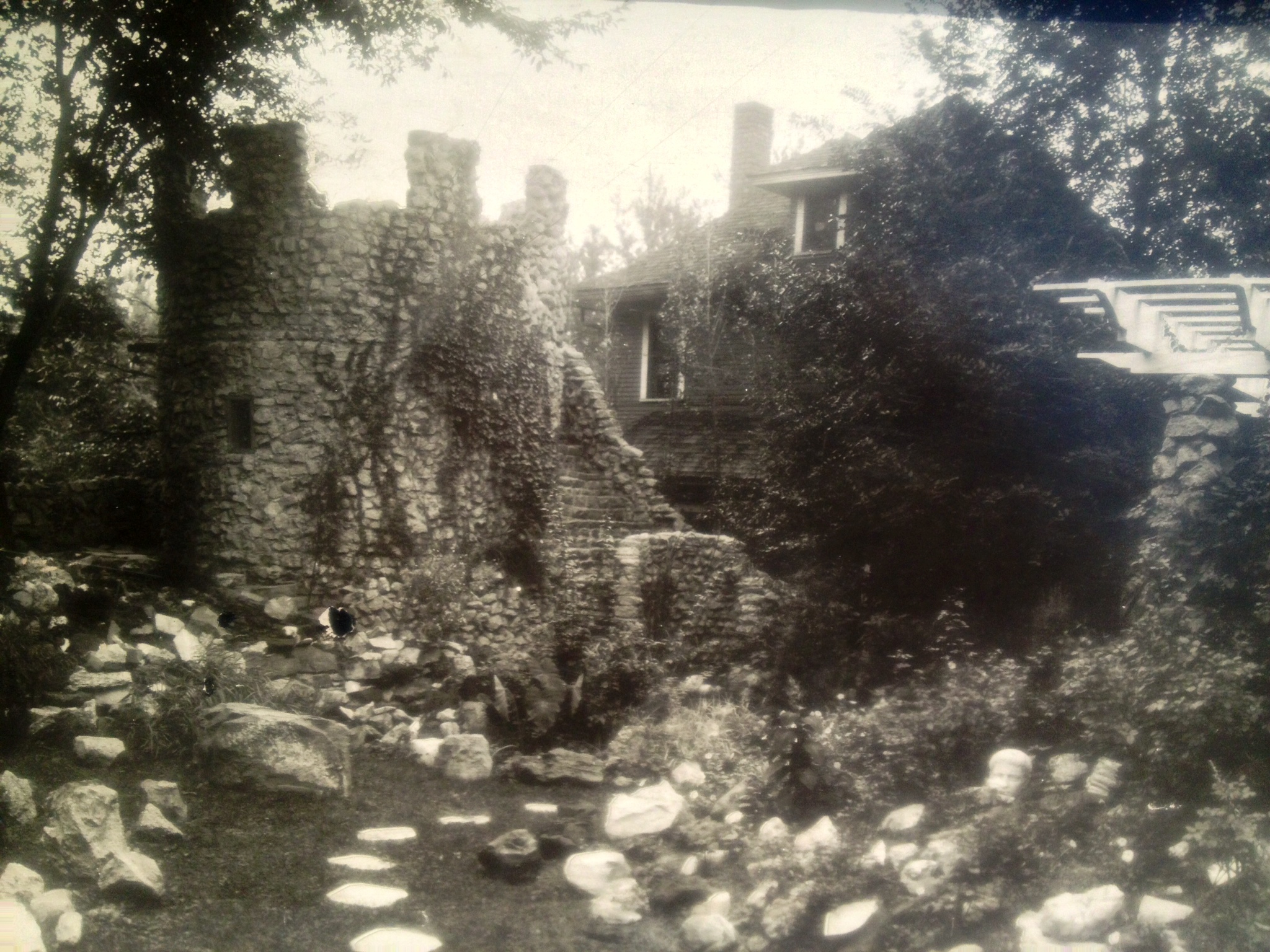
Photo courtesy of the current owners. Taken at the time of Dr. Fletcher’s Park Hospital.
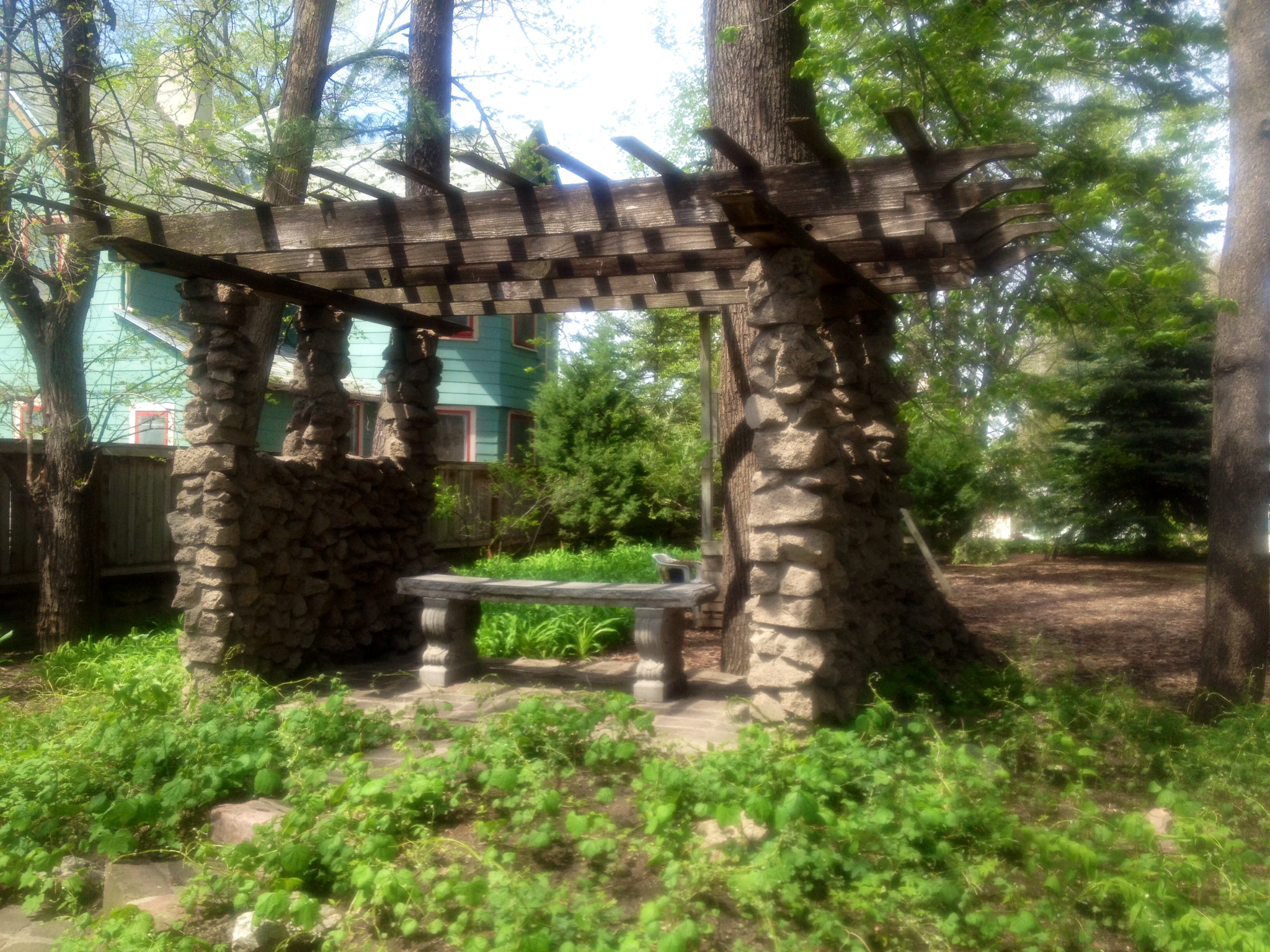
The original pergola in 2016.
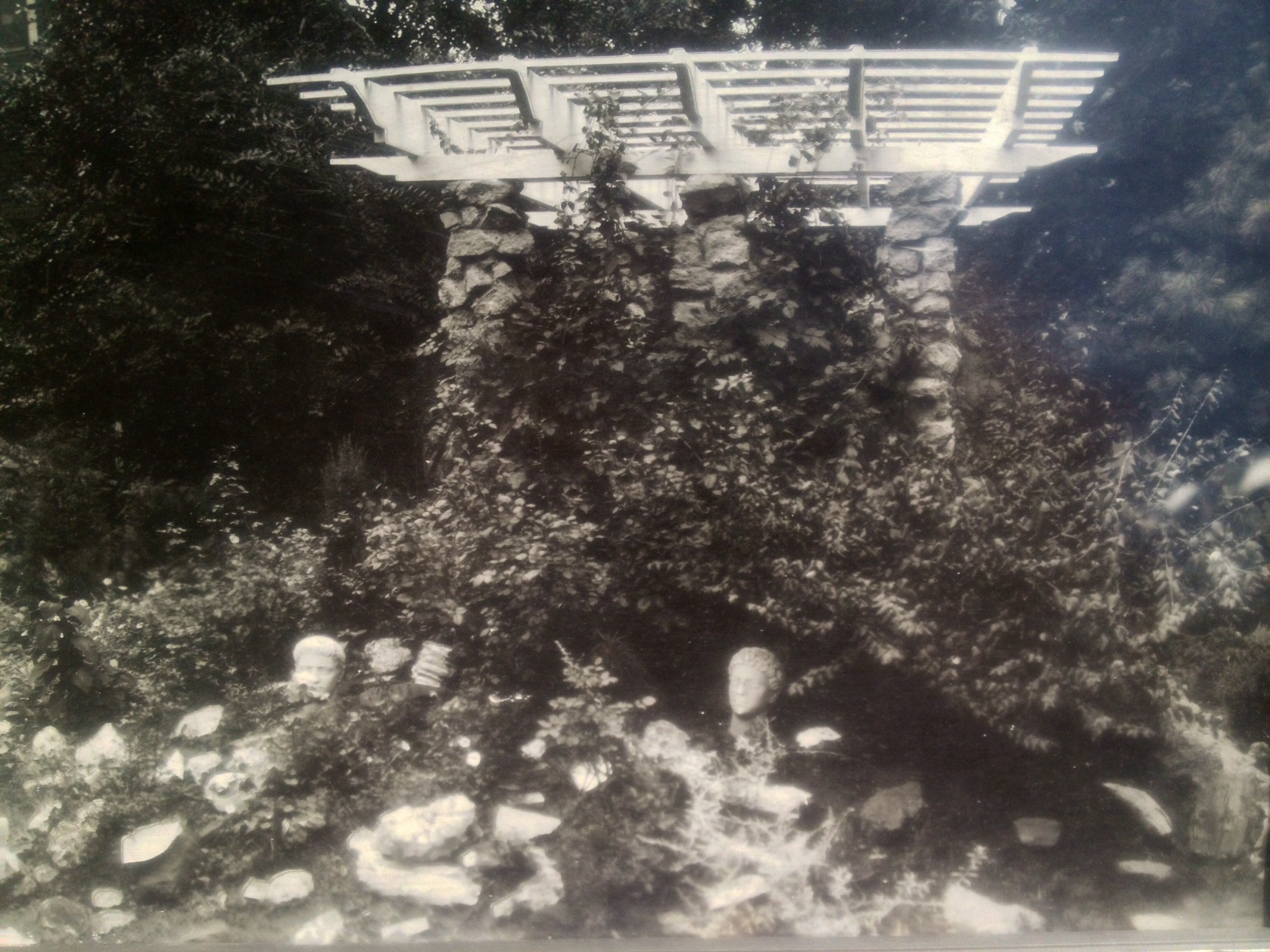
Photo courtesy of the current owners. Taken at the time of Dr. Fletcher’s Park Hospital.
Look at those heads. Just amazing.
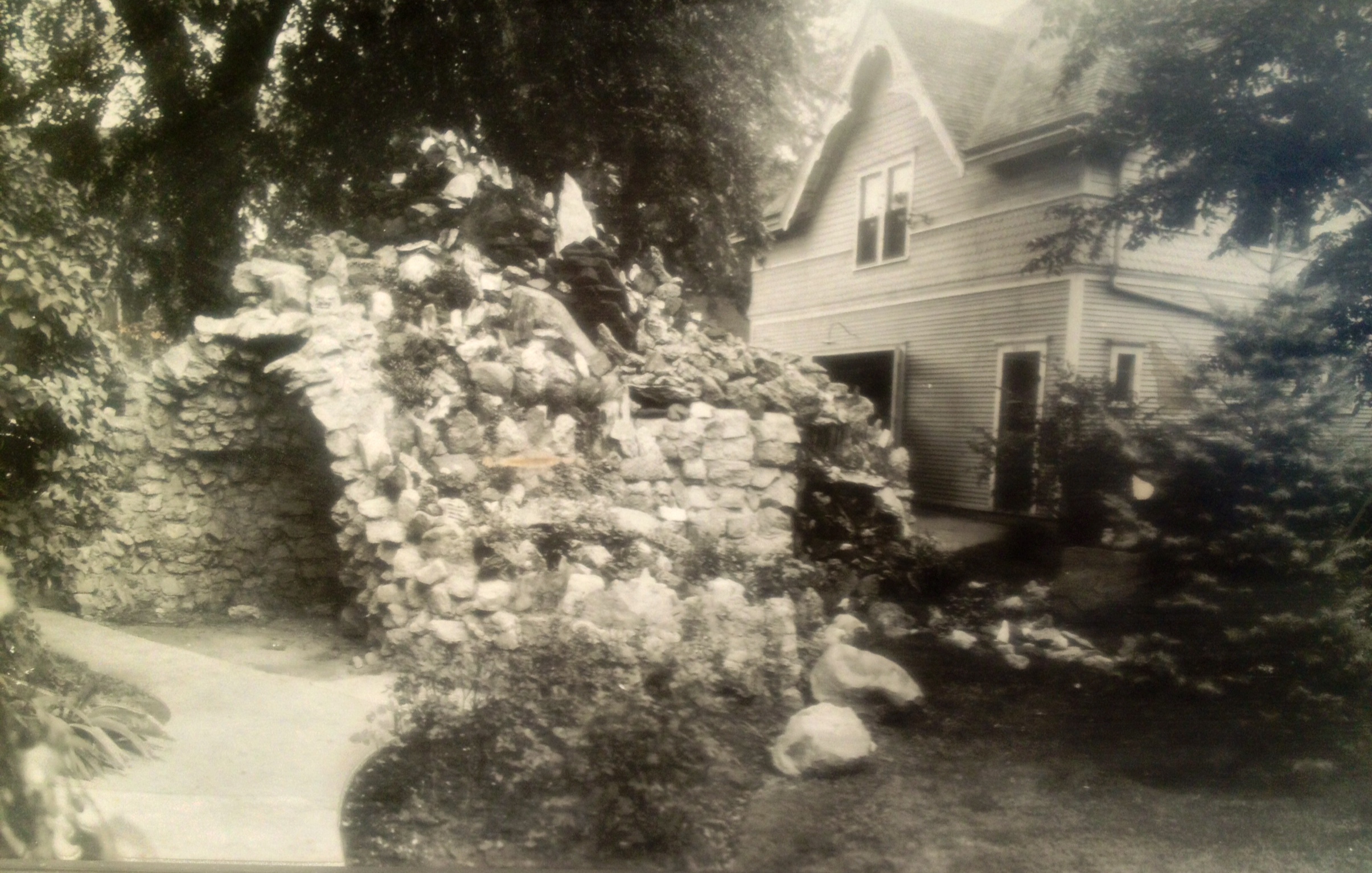
Photo courtesy of the current owners. Taken at the time of Dr. Fletcher’s Park Hospital.
The grotto, now gone, with the carriage house in the distance. Just dying…I love grottos. So breathtaking.

Photo courtesy of the current owners. Taken at the time of Dr. Fletcher’s Park Hospital. Like nature’s amusement park complete with moon stones.
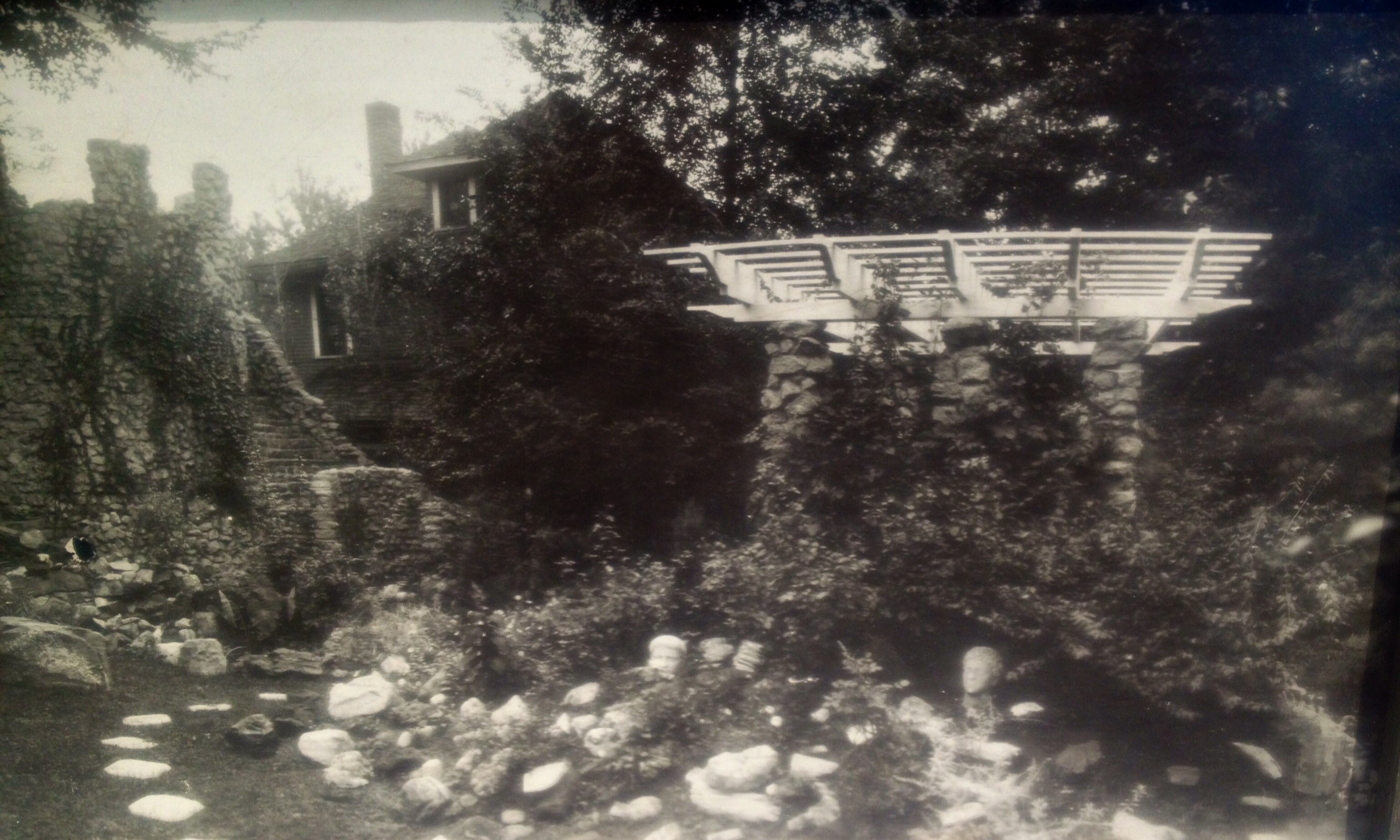
Photo courtesy of the current owners. Taken at the time of Dr. Fletcher’s Park Hospital.
The current owners reported they had bought the property from Mrs. Bryan Wilson. They shared a fantastic panoramic black and white photo taken in the time that Fletcher was running the Park Hospital with me. There were gnomes and yard sculptures with faces visible in the plantings. I could imagine by the beautiful photograph that it must have been a very healing, spiritual place in its day. At the very least, it was engaging. It still is. One of the owners said they were not sure when the grotto was taken down. There had been a pond with a stream encircling the castle and a stone path that had very large crystals lining the walk. We could see the pergola was still intact, made with broken concrete which Mr. Cassette called urbanite. There is a fence around the property constructed of this same material.
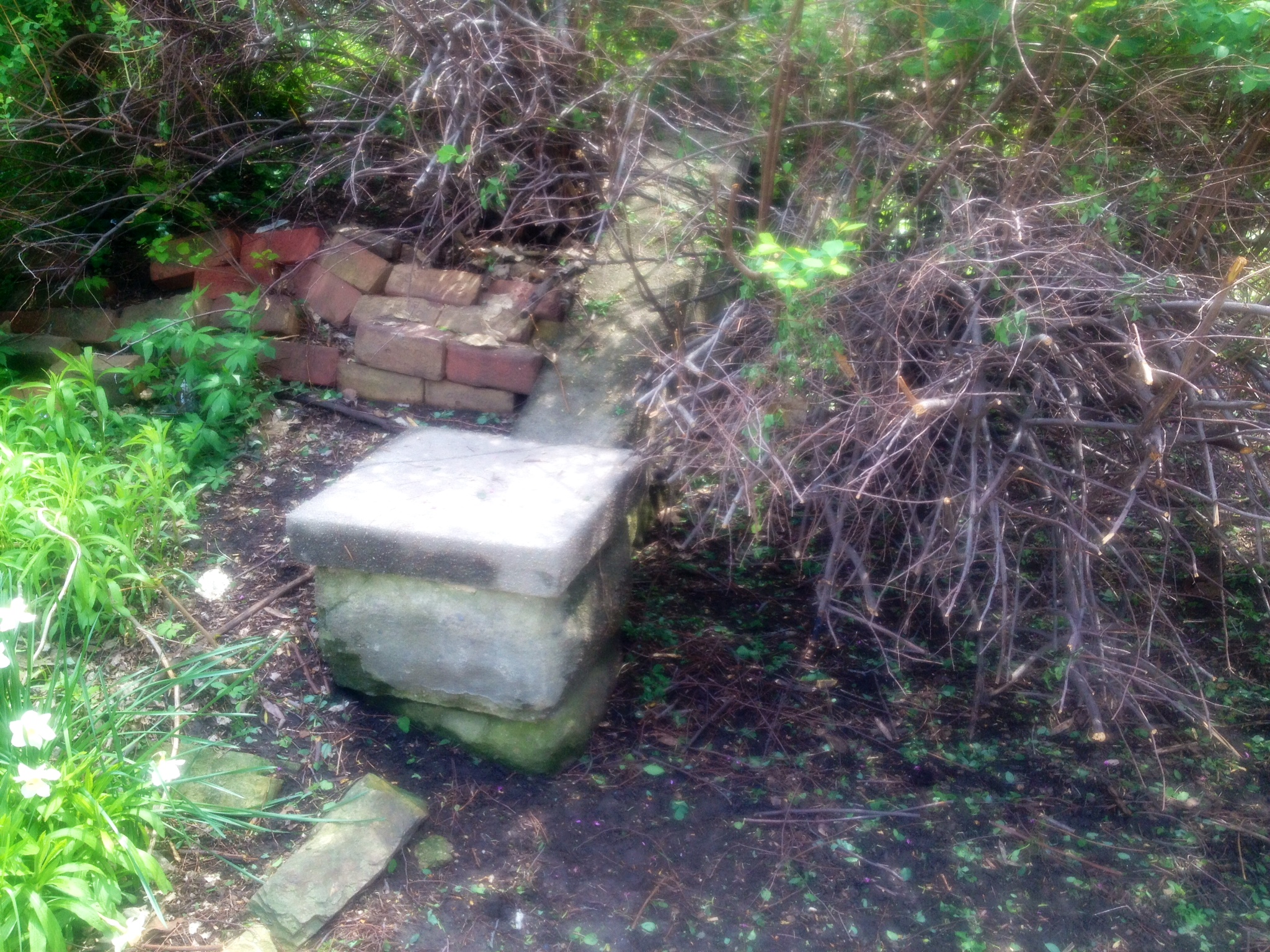
Being curious, Miss Cassette needed to walk up that wrap around staircase up the side of the castle, again. It was still a thrill. I couldn’t believe how high up it felt. I feel a little teary now as I think about it. I could look through the windows into the structure but did not go in this time. As we walked around the grounds, one of the owners gave us some other information. She shared that she had heard Dr. Fletcher had used electroshock therapy (which doesn’t really seem in line with the homeopathic field) and had invented a therapeutic drink made of urine. She called it the Park Hospital Sanatorium. She alluded to the people of Omaha viewing Dr Fletcher as something of a quack in his day—that he was an outsider. I cannot be sure if any of this is true, only that she had heard these things. What I can say for sure is that no matter his skill in the medical realm, what he created in his backyard was and still is a beautiful thing–serene, filled with variety and fantasy. It is simply compelling to imagine the Park Hospital and its park like setting of the 1920’s. It must have been so quiet back then. I dream that is why he named it the Park Hospital. As his obituary states, Dr. Fletcher left Omaha a landmark. In that fitting way, I believe he did outlive his relatives. I find comfort in that.
There is now a second part to this article. Please see Mysteries of Omaha: 4025 Izard Street Part Two.


Thank you for reading my blog. If you have any comments or stories you’d like to share about this incredible property, please do so. To enable comments, click on the header title. If you’d like to write something private or share information, you can email me at myomahaobsession@yahoo.com. Thank you, Omaha friends.
© Miss Cassette and myomahaobsession, 2016. Unauthorized use and/or duplication of this material without express and written permission from this site’s author and/or owner is strictly prohibited. Excerpts and links may be used, provided that full and clear credit is given to Miss Cassette and myomahaobsession with appropriate and specific direction to the original content.
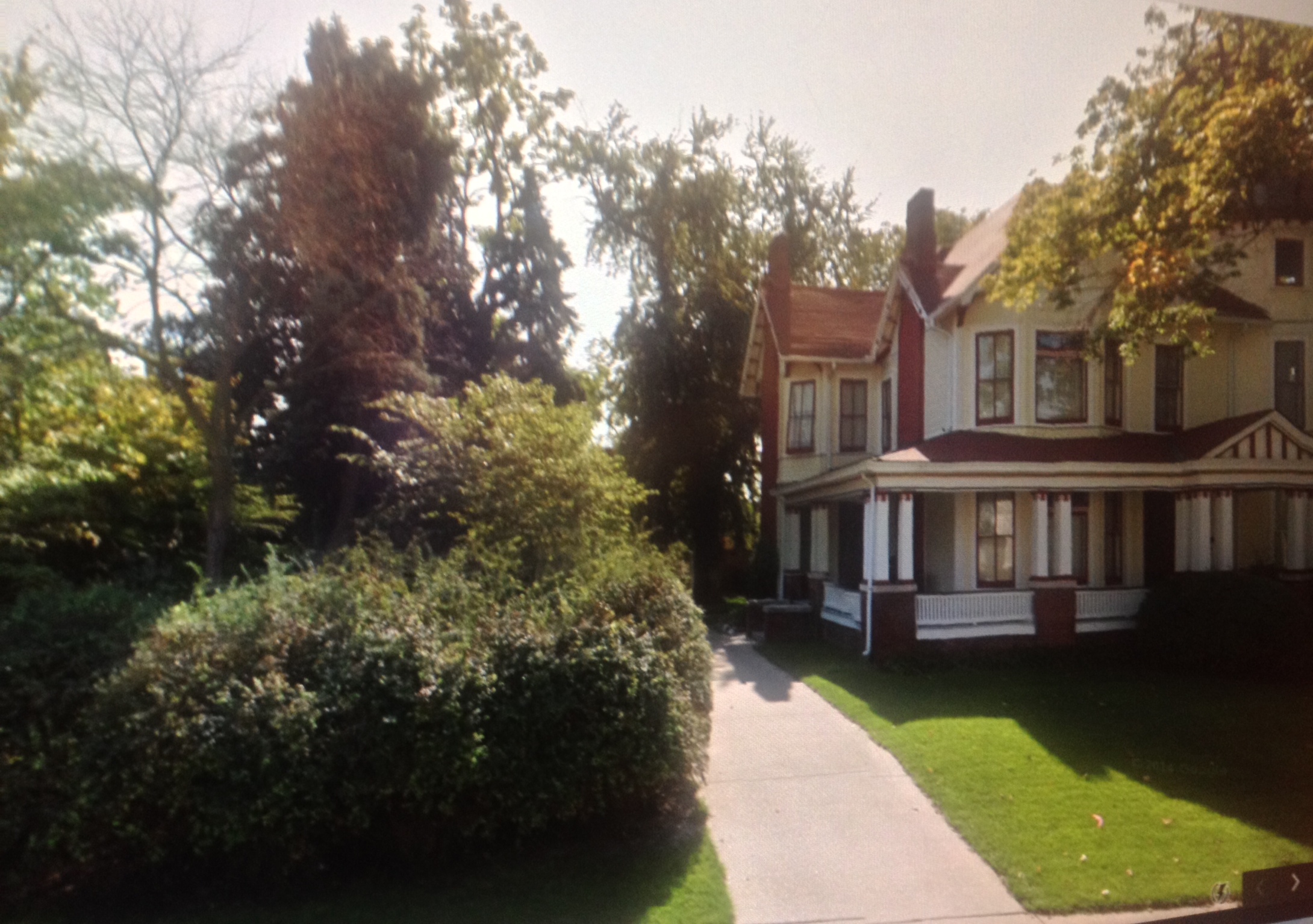
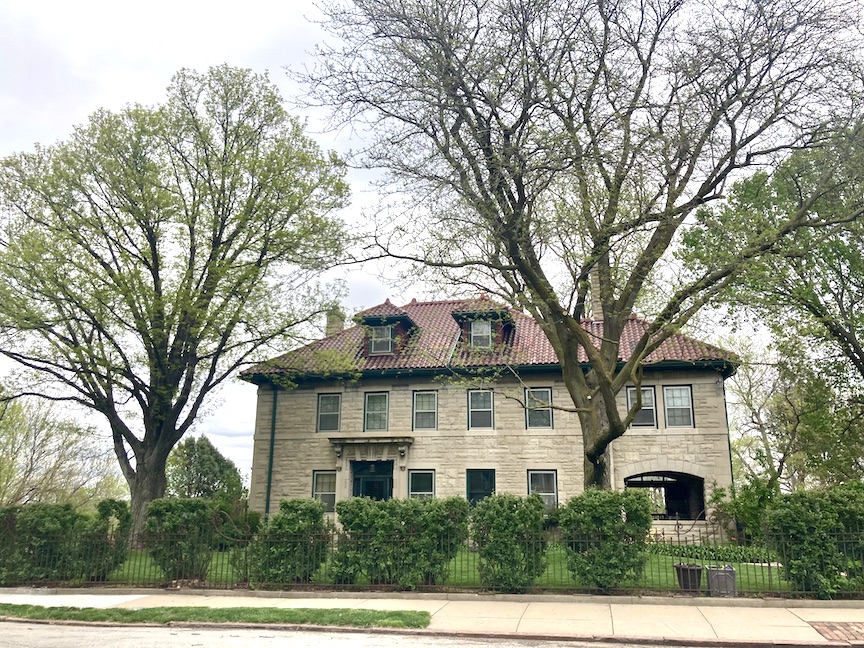
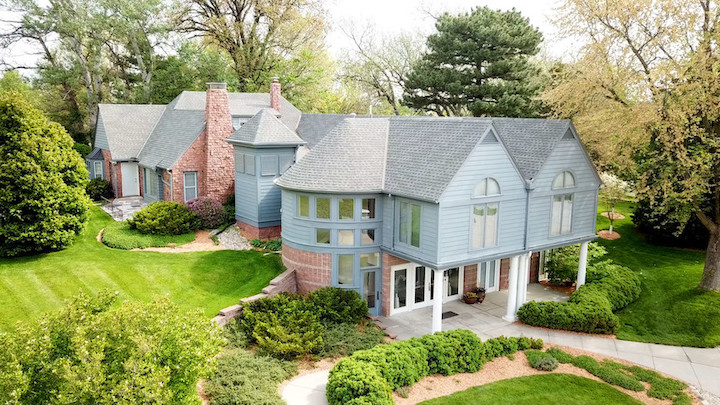
Just amazing. I hope you share this with Congressman Brad Ashford as his maternal ancestors were the Swansons and owners of The Nebraska Clothing Store–see pictures in his Omaha Congressional office at 72nd and Pacific.
Peggio
Thank you. I was aware of the Ashford’s family ties to the Ne Clothing Company but didn’t know how. I appreciate this.
Correct. Otto was Congressman Ashford’s grandfather. And a man ahead of his time when he started the Omaha chapter of the NCCJ which is now Inclusive Communities.
Love your blog! Thank you for allowing us to enjoy the fruits of your labor!
Thank you for this information. I appreciate it!
“In the years of 1916 and 1918, the name of W. O. Liljenstople was listed at 4025 Izard in addition to Swanson.”
W. O. Liljenstople married Swanson’s daughter and changed HIS name to W. O. Swanson. W. Otto Swanson became a very prominent Omahan and King of Ak Sar Ben.
Your writing is an inspiration to me, and now I want to write the North Omaha History Blog better. Thanks for that. I really enjoyed the way you unfurled your story and wove your findings into your adventure – very cool. I’ll be linking to your site whenever I can. Thanks again!
Thank you so much. That really means a lot. I’ve got to check out your blog. I will do that tonight. Thank you for the encouragement.
Whats your blog’s site? If Ms Cassette doesn’t mind you sharing here, that is.
By all means. I can’t wait to check it out myself.
Wow! I’m in love. I always loved this house (dream home, right?) but never really noted the castle in the back. Do the owners let people visit the garden and tour?
Let me know!
Hello. I would imagine this would have to be handled with care. They were firm that they would like people to ask permission. I had warned them that their drive by traffic would certainly pick up. As far as a tour, I suppose it would depend on them and the day. Good Luck
Absolutely love this article. You’ve outdone yourself, dear. Great pictures and stories. I would love to read the actual article about the man and his castle! I aspire to eventually have a yard like that. 🙂
Thank you for your comment and the feedback. I can work on scanning the article so it is readable. It is so good!
You kept me so intrigued and on the edge of my seat reading this! You do such fantastic research! Kudos my friend!
Thank you!!!
What a fascinating read. Wonderful job. Can’t wait to read more from you.
Thank you, Kathy. That is so nice to hear.
I am trying to determine if this is the Grape House or not. My husband and I would drive by now and then to look at the old houses and especially the one one that was painted several shades of purple. I also remember having a large bottle under the kitchen sink of Urego when I was young. It was a redish-brown liquid with a distinctive smell that was used whenever we kids got cuts and scrapes. I may have to ask my mom about it and see if my memories are correct.
I remember a purple gingerbread trim house too but not in this neighborhood. Let us know about that Urego!
Thank you! Wonderful blog, fabulous photos!
I really appreciate that. Having a lot of fun with it.
I happened upon your blog today and was quite intrigued with the history and obvious research efforts you put into your work. I am currently in the process of purchasing a home just a few blocks to the east at 3602 Lincoln Blvd and am quite excited to learn the history behind this beautiful property. I discovered, by chance, that the Bemis Park Wikipedia page lists this property as the George Payne house. I only hope I can do half as good a job as you have with your blog research.
Thank you for your kind words. Enjoy your new home!
The purple gingerbread house, as it’s called, is located on 36th and Hawthorne in the Bemis Park neighborhood.
Hello, yes I thought it was further east. I believe it was Susan from Second Chance’s home or she lived by there, in memory.
Susan Brink lived on the other side of Cuming, by Duchense. She never lived in the purple gingerbread house. I’m actually friends with her daughter. And my parents live in the Bemis Park neighborhood.
Thanks for clearing that up.
I noticed the castle, a couple of weeks ago, for the very first time while traveling east on Cummings, been wondering about it ever since. Thanks for quenching my curiosity.
You are so welcome. Thanks
Thanks…This is great! I might have some more material for you!
Hello Monica–
Thank you. That would be great. Feel free to email me at myomahaobsession@yahoo.com
Take care
Any information on the grand beauty at 3825 S 25th St, Omaha NE?
Oooh, good one! If it’s what I’m thinking of, was that the gorgeous house turned funeral home???
Amazing! What blogs ought to be, and so few usually are. Also: love that moss in the garden!
Oh, thank you! That means a lot. Yes, most excellent moss.
That’s so neat! I live on the 4000 block of Lafayette, and had been unable to find anything on that castle. I’m happy you found such details about one of the most unique aspects of my neighborhood!
Thank you. Enjoy the neighborhood. Good things are happening.
I found you blog fascinating and very well written. I am not from Omaha but love old homes. It is so enjoyable to get the history of the home along with the pictures. Thank you so much. I hope to read more of your work!
Thank you, Nancy. I’m having a lot of fun on my adventures. Thanks for stopping by and I hope to see you around here again.
Thank you so much for this most interesting article. I grew up in this neighborhood during the 50’s and 60’s, first at 4010 Cummings St. and then at 918 N. 40th St. I was on the grounds and in the castle on this property on numerous occasions and have some stories to tell you. I’m sorry I can not go into detail right now as I am leaving on a trip today, but will get back to you when I arrive home again. The big white stone house on Cummings where I lived was torn down many years ago and I am wondering if there are any pictures of this property somewhere. I remember it being featured in the World Herald after a severe snow storm. possibly in 56′ or 57′. I’m looking forward to talking to you.
Hi Pat, Thanks so much for reaching out. I have yet to find a photo of that home on Cuming St but I did find a short article mentioning you living there! You were 11. I would love to email it to you. Your family must have moved around 61 or 62? The house was for sale then. 4010 Cuming apparently later became a bicycle shop, then a hair salon, and later a car sales lot in the later 60s. I will wait to hear back from you.
Loved every single word! More please!
Very interesting article. Thank you. My grandfather was Fred J. Mleynek. I must admit that we have little information about the time period of his life when he apparently lived at 4025 Izard. This was between his service in WWI and the time when he married my grandmother. He would have just been starting his career with the UP. I was not aware that he had lived in a neighborhood that my family ended up living in over 40 years later. I’ll look into this more to see what we can learn. Thank you. Clark Mleynek.
Hello Clark, Thank you for writing in. How interesting that our paths would cross because of your grandfather and his connection to the home. And how serendipitous that your family would live in the same area. I hope this little piece of the puzzle takes you on a long, fun adventure! Take care, Miss Cassette
Not sure if you caught this later, but the W. O. Lilljenstolpe referenced in your article was John Swanson’s son-in-law, (William) Otto Swanson. He was born W.O. Lilljenstolpe, but changed his name to Swanson when he married John Swanson’s daughter. He started in banking but went into the family business, joining the Nebraska Clothing Company around the time he marriedWhen the Swanson’s built the house at 418 N. 38th Street in 1921 (designed by George Prinz in the Tudor Revival style), it was ostensibly built as a wedding present for Otto and his wife, but the deal was (according to family legend) that it came with John Swanson and his wife. I grew up at 418, so my family met the Ashfords, who were the son-in-law and grandson of the Swansons, and heard many of the stories.
Very interesting! I was researching Urego and came across your article. I am 62 and use to take Urego as a child for everything from constipation, sunburn, cuts/sores, and heartburn. My Mom and Grandma believed in it entirely as a wonder drug. They also bought mineral tabs from him that came in little white boxes and melted under your tongue. They were the original homeopathics….and yes, many people thought that Dr. Fletcher was a quack. My Mom is still alive and thriving in her 80’s. She has never been to a hospital for surgery and the only med she is on is for high blood pressure. So something might have been true about his potions! They bought boxes of the quart size clear bottles with reddish-brown fluid that they rationed for a decade. I sure would like to get my hands on Urego today for a skin disorder that my dermatologists can’t seem to cure. If anyone knows about this product I would be interested. Thank you.
Hi Cynthia–thanks for writing in. I hope someone can answer your question about Urego. It must have been a real miracle product! We had something similar in my family that we all used but it was more of a salve. It was a cure-all!
Let me contribute just a small piece of information. My family and I, the Charles G. Inghams, lived next door at 4031 Izard a far smaller and less pretentious house, built around 1898. We lived there from the late 1940’s until 1957. We knew both Dr. Asa and Mrs. Flossie Fletcher well and visited the property frequently. They were very good friends and very good neighbors. The castle and rock garden were well in place by the ’40’s, and Dr. Fletcher several times took me up for a tour of the castle, pointing out all the little oddities and his choices of the rocks used in its construction. His sight had begun to fail and Mrs. Fletcher had to help him around. She used to let me take him for short walks when I was a small boy, and I felt very important. She always rewarded me with chocolate cake and cold milk after I had brought the doctor back safely.
The rock garden had a small tunnel that the children of the neighborhood used to crawl through to get from one side of the yard to the foot of the castle. The small stone bridge had a pond beneath, and Dr. Fletcher used to let me put goldfish in the pond.
Mrs. Fletcher was a very kind woman and solicitous for the children of the neighborhood. When Dr. Fletcher died she told my father that she would like us to have the house, but she insisted on a price that was too steep at the time. It was one of the great disappointments of my childhood that we never came to own the wonderful Fletcher House. We left Omaha in 1957 and I always kept a fond memory of this “enchanted”garden.
(Rev.) Nicholas Ingham, OP
Thank you so much for sharing these delightful memories. I could visualize every line and I feel richer for it. Much appreciated.
I remember this place as a kid. I lived up the street in a duplex when I was about 5 or 6. I was always fascinated with this house also. My friends lived down the block and I would get there using the alley where you could see the castle. I remember there was a family that lived there that had a little girl and I actually got to enter the home. We climbed around in the castle and walked along the path where the pond was. I also remember the girl’s mom was throwing a baseball and we were hitting it with a bat and I was standing to close when the little girl was at bat and she swung and hit me in the head and I ran all the way home crying. I believe that was my last encounter at the home. But even now as a 32 year old Arizonan, I reminisce about my experiences at this lovely hidden paradise down the street from where I lived.
Oh my goodness, how mortifying! I’m that formerly little girl, now grown and probably about the same age as you. I’m sorry for hitting you in the head! I never excelled in athletics. Thank you for sharing the memory though – my mom was so kind and LOVED the neighborhood children, so she was probably just as sad that I drove you away!
We lived down the street at 42nd and Cummings and my mother worked with Brian Wilson.
I played in the castle a few times back in the 60!s and it was very y cool. Brian Wilson was a very tall lean gentle man. Love all your work on this . I never knew any of this growing up in the neighborhood.
My nephew and his wife bought the house. I just heard on Friday that they were moving in and that’s why they weren’t at Thanksgiving. Unbelievable to me that anyone from my family would live in such a house.
Sincerely,
Jeanne Schendt
Hi Jeanne–Maybe they’ll throw Thanksgiving next year! Wouldn’t that be a dream? Thanks for writing in.
My Mother, Father and I used to live in the house. My mother left when I was 2 leaving my Father and I to resign in the house. We didn’t live there long because he owned a carnival and it Father expanded to a a full-size Circus and we left the house when I was 4 years old and didn’t come back. I remember in the last few months we lived there, Father had someone come to look at the house to look at it- who was interested in purchasing it. I often feared that this beauty’s house was completely abandoned, but I was pleased to see it had been bought later by Bryan Wilson and then by the Taylor’s.
Interesting that my Mother’s name was Taylor.
Fascinating read! The photos have triggered some memories of my childhood!
I have been inside that beautiful home and played on the grounds and in the castle!
I lived across the street from 1989 to 1994!
What a treasure to have as part of Omaha’s history!
This was very interesting. I lived in the neighborhood on the corner of 41st & Izard in the early to late 60’s from age 6 to 13 I remember exploring the ruins of the “castle” with friends as kids. I didn’t know who lived there at the time but I remember people from the neighborhood referring to it as a former hospital. We, my friends and I, always wondered what the castle was originally built for, so thank you for this.
Another stunning investigation. You have a gift Ms. 8-Track , (Sorry, couldn’t resist, some Boomer humor)!
I grew up as drug of society and did not know the ..Job’s Daughter’s was founded in Omaha!
Link: https://en.wikipedia.org/wiki/Job%27s_Daughters_International
Keep up the great work. Super entertaining and insightful. Thank you!